What is China really like? It depends who you ask.
China would like to tell you that it’s a prosperous, modern, harmonious society, a reliable and stable superpower in a world of stumbling democracies, whose people enjoy unprecedented peace and prosperity thanks to the wise governance of the Chinese Communist Party. If the endless state-sponsored Instagram reels that I admittedly quite enjoy are anything to go by, the whole country is made up of high-tech futuristic cities dotted around the immaculate countryside, all held together by national pride, enduring cultural traditions, and the world’s best high-speed rail network.
The West, however, is keen to paint quite a different picture - one of an oppressive, backward adversary, the antithesis of Western democratic ideals, whose rapid economic development comes at the cost of, rather than to the benefit of, world peace. In this China, the self-serving government prioritises its quest for global hegemony over the freedom and wellbeing of its people, rewrites narratives past and present to keep its oppressed population loyal, and, of course, absolutely hates the West.
Those two perspectives are pretty hard to reconcile. During my time at Cambridge, I met people from all across this spectrum of belief, constantly hearing such egregiously contradictory viewpoints that I almost began to doubt whether everyone was even talking about the same place.
Naturally, I was fascinated by this, and as I learnt more and more about the incredibly complex history and culture of the country, my fascination only grew. Therefore, when I realised that between graduation in July (oh yeah, I finished my final year at Cambridge!) and starting work in September, I would have my final contiguous six-week block of total freedom for the foreseeable future, there was no question as to what I would do. The only way I could truly answer the question as to what China is really like was to go there.
In this blog post, I’ll finally be giving in to the urge to write a travel post about the greatest adventure of my life so far, discussing what I got up to on my six-week solo trip around China, what I learnt, what I thought, and what I felt, as well as sharing my new-found perspective on the world outside of the West. Six weeks is a lot to condense into one piece of writing - heads up, it’s 25% longer than my dissertation - but I hope this post gives you some insight into my experience in China, a story that begins at Terminal 2 of Shanghai Pudong Airport.
上海 Shanghai
After a surprisingly short and reasonably comfortable flight, I landed in Shanghai to begin my adventure. I had printed reams of documents just in case they asked for them at the border, which they did, but eventually I was allowed in and my adventure could begin. I took the futuristic maglev train from the airport into the city - well, halfway into the city, because it randomly stops in the middle of nowhere - and excitedly made my way to my hotel.
For my first afternoon in Shanghai, I walked down Nanjing Road to the river to watch the sunset and see all the buildings light up, which was incredible… until the heavens opened and I was welcomed to the city by one of the heaviest downpours I’ve ever experienced. On the upside, it was a baking hot day and the rain very effectively cooled me down, but on the downside, it also very effectively soaked my passport, and some quick thinking with a hairdryer was the only thing between me and being stranded in China for ever more. Fortunately, I just about managed to save the hours-old immigration stamp from total destruction, but I’m definitely going to need to get a new passport when/if I get home.
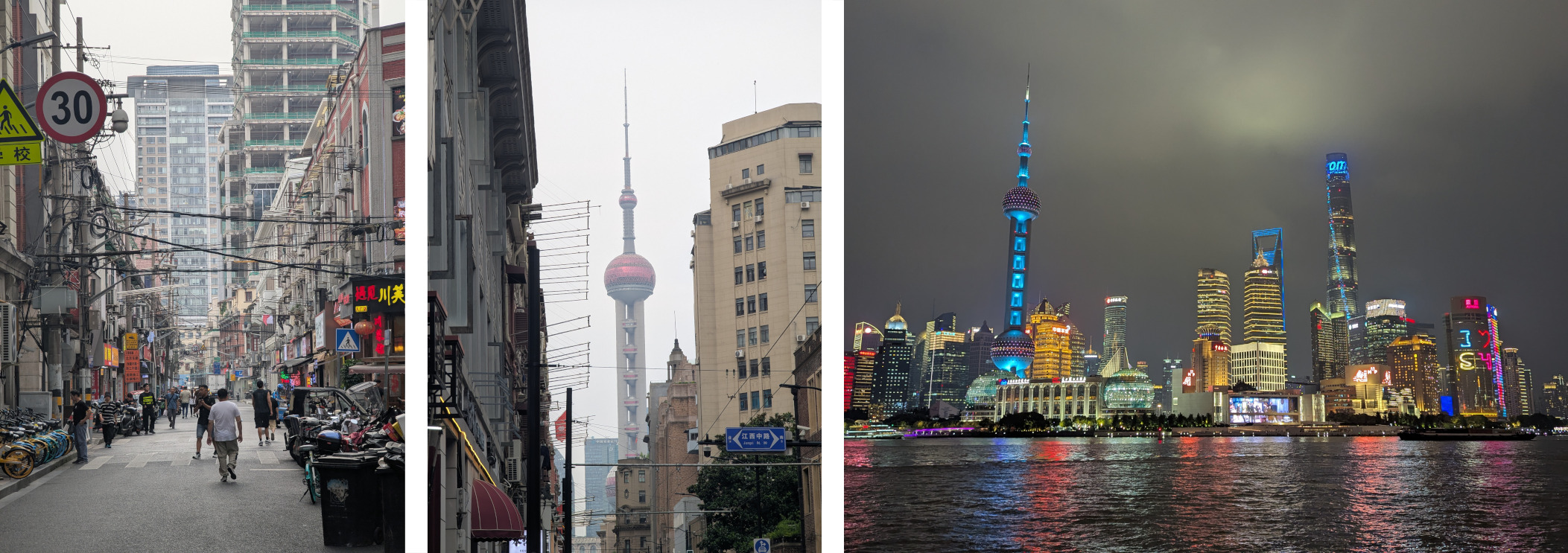
Left to right: a street off Nanjing Road, a view towards the Oriental Pearl Tower, the skyline across the river
One thing I was wholly unprepared for, despite being warned about it, was just how interesting Chinese people find foreigners. I had thought, naively, that being arguably the most international city in mainland China, the novelty of seeing a foreigner would have worn off for people in Shanghai, but I could not have been more wrong. The first time someone approached me, I thought they were asking me to take a photo of them, but no, they wanted to take a photo of me. Several people wanted to talk to me and practice their English (my ability to hold a conversation in Chinese was, at least at the beginning of the trip, somewhat limited), some people wanted selfies with me, etc. It was an extremely strange feeling to BE the tourist attraction, and one that persisted throughout the trip: not a single day went by without a couple of selfies!
The weather the next day wasn’t great, so after a nice walk through the Lujiazui area of skyscrapers during a break in the rain, I went inside to have lunch. I found a nice little restaurant and ordered this delicious “medium spicy” fried noodle dish, but I forgot the scale is calibrated a bit differently over here so I had to have ice cream afterwards. The rain didn’t relent after lunch, so I decided to have a look at the Shanghai Museum, which ended up being one of the highlights of my time in Shanghai! They had an exhibition on Ming Dynasty art (1368-1644; the museum assumed everyone already knew the dates of all the dynasties so I had to keep looking them up), which I had never seen before and which is now my favourite style of art - I love how the artists manage to combine such huge imposing landscapes with quiet human details to make a really powerful image of China at the time. I definitely need to get a print of one of them for my new flat in London.
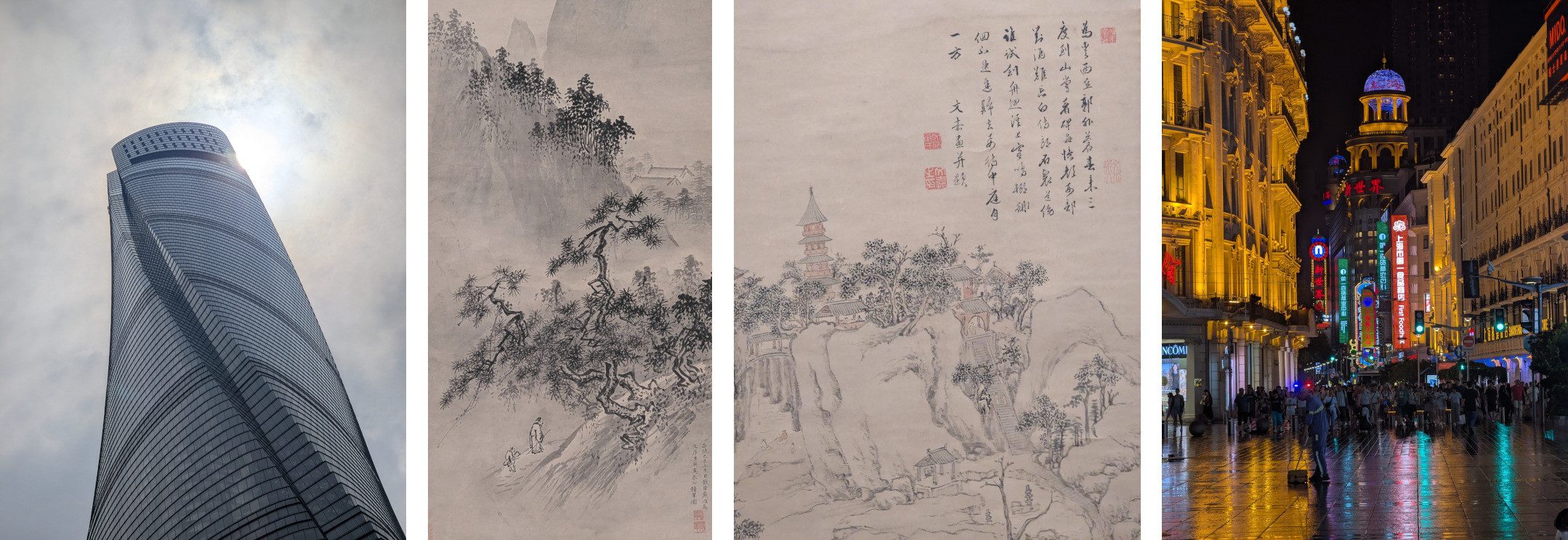
Left to right: the Shanghai Tower, “Dense Green on Spring Mountains” by Dai Jin (1449), another Ming Dynasty scroll, Nanjing Road
For my final full day in Shanghai, I wanted to see something less touristy and more authentic, so I found some villages right at the end of one of the metro lines and caught the train all the way out there, then walked for a few miles into the countryside. It did not disappoint! Being from a small village in the UK myself, it was really interesting to see how the “village vibe” is exactly the same on the other side of the world - posters everywhere advertising village events especially reminded me of home. I went to the only restaurant in the village and had a bayberry soda (very delicious) by the river, which was a really nice vibe.
As I was walking and looking at the map, I discovered that there was an ancient water town nearby called Zhujiajiao, so in the afternoon I went to check it out. Busy streets lined with cute little shops ran alongside beautiful canals packed with very Cambridge-esque tourist boats, but despite the crowded thoroughfares, the huge gardens hiding behind the buildings were nearly empty (some of them had entrance fees, albeit minimal ones, which I think helped!). I spent several hours wandering around the town, much of it in the amazing gardens where late Qing dynasty (early 1900s) Chinese nobles would have done extremely noble stuff like drinking tea, reading books, and thinking.
I got back to the centre of Shanghai in the early evening and, after some delicious xiaolongbao (soup buns) for dinner, I decided to end my time in Shanghai with a night-time trip to the top of the Shanghai Tower, the tallest building in China. I had to wait quite a while for a gap in the clouds (foreshadowing the next part of my trip…), but once the clouds parted the view was absolutely incredible - it’s so ridiculously high up!
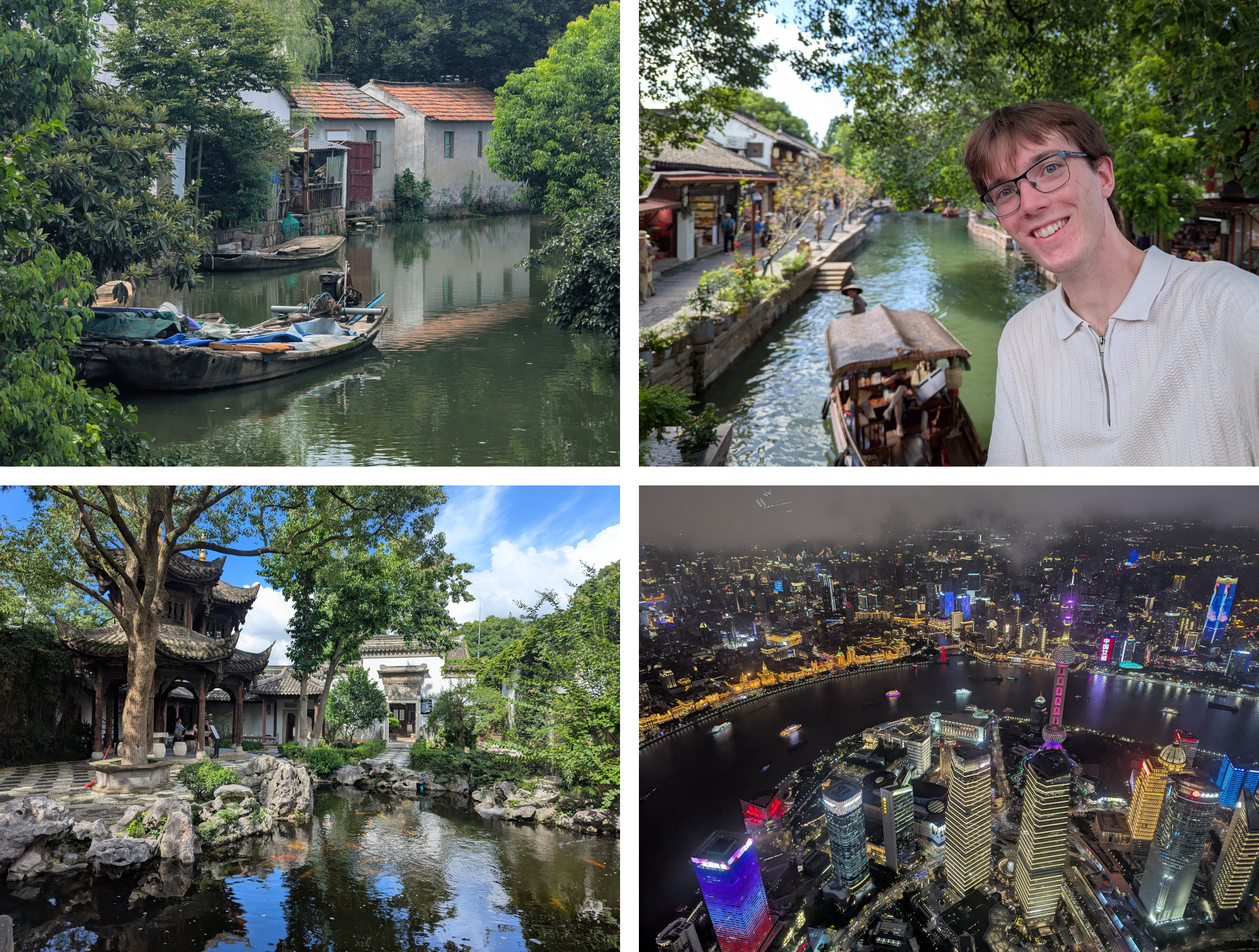
Clockwise: a small village, a canal in Zhujiajiao, the view from the Shanghai Tower, one of the gardens (one of them is old and one of them is modern but I can’t remember which one this is)
Shanghai was the perfect place to start my trip. In many ways it felt like a gentle introduction to China, a welcoming middle-ground between the Western cities I’m used to and the Chinese world I was beginning to explore. Western and Eastern architecture sit side by side; European-style cafes are dotted among the traditional Chinese restaurants; the metro accepts Visa as well as Alipay. It gave me the chance to get to grips with important logistical and social differences of China (paying for things, public transport, etiquette) in a more familiar environment, almost like the tutorial level of a video game, introducing the mechanics of China slowly and individually before setting me free into the rest of the country.
黄山 Huangshan
After seeing the huge city of Shanghai, I ventured inland by way of high-speed rail for a complete change of scenery: Huangshan, the Yellow Mountains. Taking the train in China is a completely different experience to that in the UK - you have to go through security, check in, and show your passport a bunch of times, but the train was perfectly on time, very comfortable, and relatively cheap too. My original plan was to take a taxi from the nearest train station into the mountains, but my success with the train left me feeling very confident in my public-transport-taking abilities so I decided to continue the streak and take two buses instead. My confidence was maybe slightly misplaced because I got extremely lost changing buses (there were actually two separate bus stations next to each other for some reason) but after an hour of wandering around I finally found the second bus that took me to the mountains.
Even just getting out of the bus at the foot of the mountains I was in awe, but taking the cable car up and then stepping out into the fresh breeze, looking over the lush green trees and jagged rocks was an indescribable experience. After quickly dropping off my bags at my hotel (which was maybe 80% of the way up the mountain), I went back out to explore and take in the unbelievable views, ending up at what I was told was one of the best spots to watch the sunset. As the sun got closer to the horizon, thick clouds suddenly began to roll over the mountains, bringing with them cold and heavy rain, but me and a couple of other dedicated people braved the inclement weather in the hope that the clouds would part in time for the sunset. And, about an hour later, just as quickly as they had appeared, the clouds gave way just enough to reveal the most beautiful sight I have ever seen.

Left to right: me in the mountains, the beautiful sunset (x2)
The feeling as the clouds parted was one of the most incredible things I’ve ever experienced. The anticipation, the breathtaking natural beauty, the unspoken camaraderie with the few other people crazy enough to stand in the rain together for an hour with no guarantee of success - it was undoubtedly one of the highlights of the whole trip. The moment must have lasted just a couple of minutes before the clouds rolled back in, but I couldn’t stop smiling for the whole hike back to my hotel in the fresh foggy night.
I set my alarm for 4:30am the following morning in the hope that the clouds would have passed in time for me to watch the sunrise too. They didn’t, but watching the misty sky get lighter, hearing the birds start singing, and exploring the completely deserted mountain at dawn all by myself was another amazing experience, although after an hour my body remembered it was 5:30am so I went back to sleep for a bit. Once I woke up again at a more reasonable time, I went for a long, difficult, but amazing hike, losing 1000m of elevation and then gaining it all back again. The vast majority of the tourists stayed at the top of the mountain, so I saw almost nobody for the whole walk, which was lovely. Once I got back to the top, I ate some food, had a rest, and then, like the day before, waited in the well-timed cold and rain hoping to see the sunset. This time was even more fleeting than the last - the clouds gave us at most a 30-second glimpse of the sky - but just like last time, those 30 seconds made the whole thing worthwhile.
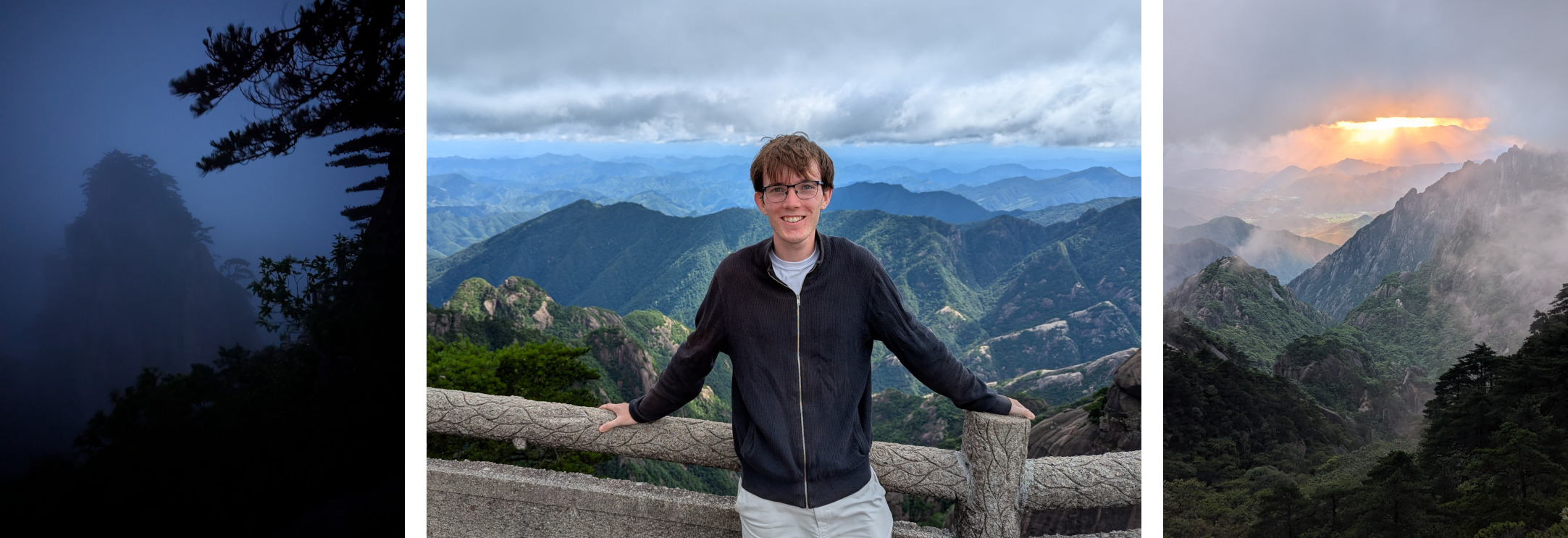
Left to right: a foggy dawn, me at the end of my hike, a fleeting glimpse of Heaven
My final day in Huangshan started much like the previous, far too early and in a cloud. However, unlike the previous, said cloud was slightly more merciful and actually revealed some of the sky, which was a really beautiful start to the day. I had to check out of my hotel quite early, so I decided to hike all the way down the mountain instead of taking the cable car, which, despite having to carry both of my bags, was surprisingly doable (it took me half the time that the sign saying “warning: you should probably take the cable car” suggested it would take!). I then got lost again with the buses (why do they drop you off and pick you up in different places??) but eventually made it back to Huangshan City.
It felt like quite a small and old city, and I really liked the vibe. I explored for a bit before finding this really cute little restaurant for a late lunch. The single room was barely big enough for the four tables it contained, let alone the tiny kitchen in the corner, where this really kind old lady prepared all the food (alongside doing every other role in the restaurant too). My Chinese was just about sufficient to order this local noodle soup dish, and I wish I had understood all the stuff she told me about it, but what I can say is that it was absolutely delicious.
After some more exploring and a brief return to my hotel room to do some admin (travelling around China for six weeks unfortunately requires quite a lot of that), I ventured back out in search of a specific iconic local dish for dinner: stinky mandarin fish. The name did not fill me with excitement, but I was told that it’s a classic Anhui dish and it actually tastes good, so I had to give it a go. I found a restaurant which, according to the Chinese equivalent of Google Maps, does the best stinky mandarin fish in the city, so I hoped if anyone could make it taste good it would be them. I’m not exaggerating when I say I could smell it well before it was even in front of me - it definitely lives up to its name, it smells SO BAD. I was pretty nervous to take the first bite (my brain was screaming “this smells so off, do not eat this!!”) but I was relieved to discover that it does actually taste really really good. I just don’t understand why they would make such a delicious dish smell so bad, why not make it smell good too?? It took me a while to figure out the optimal technique for eating a whole bony fish with chopsticks, but I managed in the end and polished the whole thing off, which apparently impressed the restaurant staff very much.
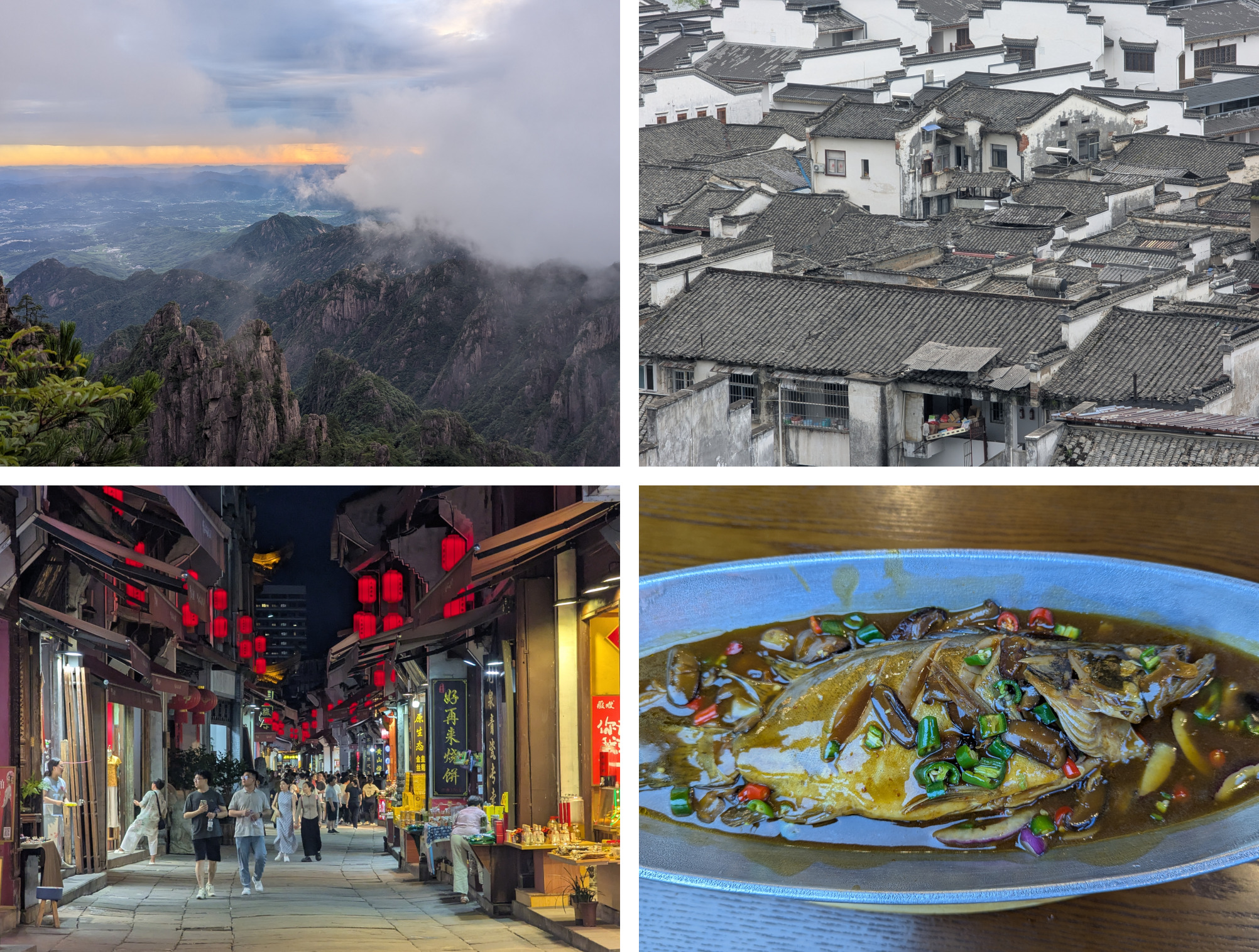
Clockwise: sunrise, Huangshan City, smelly mandarin fish, the city in the evening
北京 Beijing
The next morning, it was back to the train station to make the seven-hour thousand-mile journey north to the capital. It went by very quickly (because I spent most of it writing the section you just read about Huangshan!), and I got to Beijing in time to have dinner and go to sleep before an early start the next day.
My first full day in Beijing began with me promptly leaving Beijing at 6am in an attempt to beat the crowds to the Great Wall of China. It was a very successful morning: not only did I successfully find and take the earliest bus out to the wall (my first true bus success), I also did manage to be among the first to get there! Walking along the wall in the quiet early-morning fog with barely anyone around made the minimal amount of sleep I got the night before all worth it. It sounds a bit stupid now but I didn’t realise just how big the Great Wall of China is - it goes on and on and on over the mountains as far as the eye can see (which, on such a foggy day, was not that far, but trust me on this one), and not only that, it has huge watchtowers every few hundred metres too. Despite the rain, the ever-increasing numbers of tourists, and the perilously slippery wall, I had a great time walking as far as I was allowed to go and back again before returning to Beijing in the afternoon.
After the obligatory and absolutely delicious Peking duck for dinner (how they manage to make the skin so perfectly crispy and the meat so tender I do not know), I went to Houhai, a lively area of food, drink, and music by a beautiful lake, for an evening stroll. The vibe was amazing and it was the perfect ending to an already excellent day!

Left to right: the foggy Great Wall of China (x2), Houhai in the evening
I got up early again the next day to visit Tiananmen Square, not knowing at the time just how necessary my early start would be… I got off the metro at 8am, and after two hours, two full kilometres (I measured) of snaking police barriers lined with police officers, three ID checks, two very comprehensive pat-downs, and one poorly-timed thunderstorm, I was finally allowed into the square. In a way, the extreme security setup actually added to the experience: a kind of implicit acknowledgement of that which must not be acknowledged; my first glimpse of the China that Western media/propaganda (delete as appropriate) loves to describe. The square itself was pretty unexciting - it doesn’t even have a fountain, can you believe it - but Tiananmen, the huge entrance gate to the Forbidden City, adorned with a portrait of Mao Zedong and now an iconic symbol of China, was really interesting to see.
Walking through the gate (and yet another security checkpoint), I entered the Forbidden City and, like with the Great Wall, was completely blown away by its scale. It really does live up to its name of being a city - endless grand palaces, gardens, squares, and tourists fill the huge compound, and I got happily lost exploring it and learning about the various emperors and empresses of the past. I had an hour’s pause to have lunch and spam-click the refresh button trying to get tickets for a concert later in my trip (I got them! But more about that later), then continued my exploration into the afternoon, ending up at Jingshan Park with a beautiful view over the whole Forbidden City.
My days in Beijing largely followed the same pattern of a big adventure in the day, then a short return to my hotel room to recharge my phone and myself before heading back out for dinner and an evening activity. This day was no exception, so after a brief rest I went to Qianmen Street, a historic commercial street south of Tiananmen Square, where I had baodu (quick-boiled tripe, another Beijing dish) which was delicious, especially the amazing sauce, and a Beijing pie because I am greedy. I also came across a shop that sold huge ice creams for 30p, so naturally I had to pay it a visit (or three).
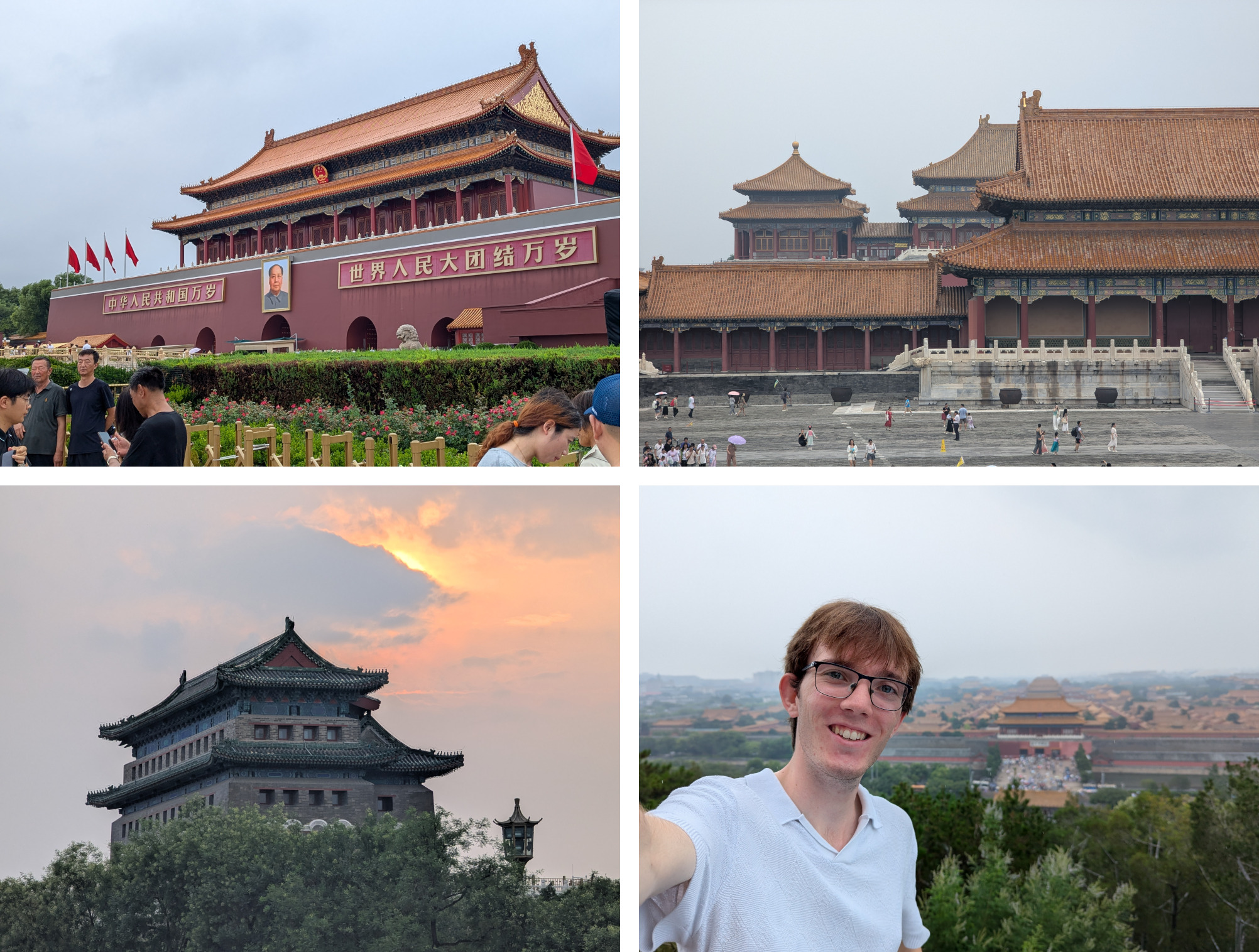
Clockwise: Tiananmen, the Forbidden City, the view from Jingshan Park, Qianmen in the evening (and the closest I got to seeing the sun during my whole time in Beijing)
When I was booking tickets for my Beijing activities while I was in Huangshan, I made the mistake of giving myself three early starts in a row, so the next day was a slightly more challenging early start to visit the Summer Palace, a historic imperial garden and lake in the north-west of Beijing. Once I finally managed to get in (my ticket didn’t work so I had to queue up to buy a new one, but fortunately the website I booked it through refunded me for it), I went for a beautiful and surprisingly quiet walk around the lake, taking in the views of the ancient buildings and bridges and somehow getting sunburnt on an extremely cloudy and foggy day. Away from the main lake, beside a quiet lotus-filled lagoon, I stumbled across a little cafe with tables going right down to the water, and, despite its unavoidable un-Chinese-ness, I couldn’t resist the allure of the most delicious-looking tiramisu that caught my eye the moment I walked in. It was just what I needed to power me around the rest of the lake, and I ended my walk by visiting some of the amazing buildings before moving on to the afternoon’s quest.
The Summer Palace is very near to both Peking University and Tsinghua University, the Oxford and Cambridge (or Harvard and MIT, for my readers across the pond) of China, and I was really hoping I would be able to visit at least one of them to get some tiny insight into what university is like in China. However, in order to visit, you need to make a reservation beforehand (it can be immediately before), and in order to do that, you have to submit your Chinese ID card number, which surprisingly I don’t have. Apparently they can make exceptions if you email them early enough and are from Hong Kong or Taiwan, but the UK is pretty unambiguously not China, so I returned to the centre of Beijing a bit disappointed from taking the major L of not being Chinese.
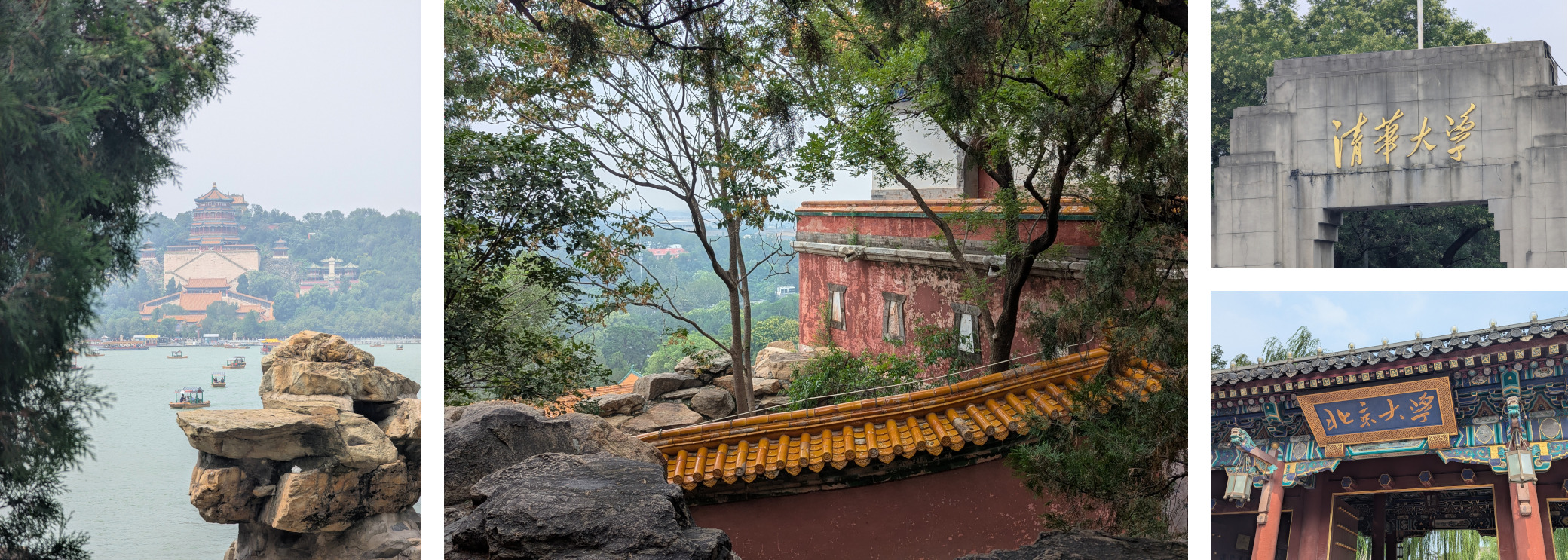
Left to right: the Tower of Buddhist Incense across the lake at the Summer Palace, the view from the hill at the Summer Palace, the closest I got to visiting a university in Beijing (top: Tsinghua, bottom: PKU)
The negative vibes didn’t last long, however, as I went to explore Nanluoguxiang in search of dinner. This is a noisy, crowded, and incredible ancient lane lined with all sorts of amazing restaurants and stalls. I had zhajiangmian, a classic Beijing dish of noodles topped with fermented soybean paste, meat, and vegetables, which was one of the culinary highlights of Beijing for me, and as I walked further down the lane after eating I also got some fresh bayberry juice from one of the stalls, which was so good I really need to figure out how to get it in the UK. My fantastic Saturday night didn’t stop there, however, as I ended up walking back to Houhai, where one of the many bars by the lake with live music caught my eye (or, ear I guess?) - the band sounded really really good, so I surprised myself by putting aside the awkwardness I felt about going to a bar alone and went in, bought a ridiculously overpriced drink, and enjoyed several hours of amazing music and amazing vibes. They even played some of my favourite Chinese songs!
For some reason I had in my head that London is very bad at late-night public transport compared to Asia, and so I assumed that, since much of the tube runs all night on Friday and Saturday nights, I would have no problem taking the metro home in the early hours of the morning in Beijing. I was very wrong - the Beijing metro stops at like 11pm even on Saturdays, so at 2am I had the exciting task of figuring out how to use Didi, the Chinese equivalent of Uber. Fortunately, it works literally exactly the same as Uber, and my 15-minute taxi back to the hotel cost me £1, which was almost unbelievably good value.

Left to right: Nanluoguxiang, zhajiangmian, the bayberry juice stall, the band
At long last, on my final day in Beijing, I was able to have a much-needed lie-in. I had left the day unplanned as a more relaxed day, so once I finally got up around 11:30am, I decided I would start by visiting the National Library of China, something I only discovered because I happened to go on a metro train through its station on one of the previous days. As well as a fascinating museum about ancient Chinese books (I particularly liked a comparatively modern 300-year-old book about arithmetic), there was an enormous reading room full of people working extremely hard. I did run into the same problem of not being Chinese and hence not being allowed in (okay, technically this time foreigners could get in if they applied for a special foreign reader’s pass a few days in advance), but a very kind librarian made an exception for me so I was able to explore. I looked really hard for a book on category theory (there was none), but I did find “how to use ChatGPT in data science”, which I thought was amusing given that ChatGPT is banned in China.
After the library, I went to a beautiful park which had an amazing canteen-like place filled with locals where I had lunch. I had a delicious bowl of noodles with pork for £1.50, and the people I sat with were really nice and friendly (as everyone has been!). As I walked through the park after lunch, I thought of two more things I would quite like to do before I leave Beijing: see some Peking opera, and obtain a large quantity of bayberry juice to bring home. For the first, I couldn’t work out how to buy tickets online, so I just showed up at a couple of theatres to see if they had a performance that evening. The first one I tried was half demolished, which was not a good start (thanks for the recommendation, DeepSeek, much appreciated), and the second one didn’t have any performances until the following week. My second quest, I thought, would be easier - just find a supermarket and buy some bayberry juice. All the big supermarkets are away from the centre of the city, so I headed out to the biggest one I could find. I always love seeing supermarkets in foreign countries, and this was no exception, with its massive piles of fruit, vegetables, and spices, live seafood, aisles and aisles of every different kind of oil… it was really cool. I found the bayberry juice I was looking for, but I had overlooked one rather important thing: fruit juice goes off. It would barely have got to Hong Kong (oop, spoilers!), let alone back to the UK. Despite this, I bought some anyway, and it didn’t even get back to my hotel, although that might’ve been for unrelated reasons.
I went back to Nanluoguxiang for dinner to try another restaurant I had seen the previous day, which was pretty good, and then decided to finish my time in Beijing with another walk through Jingshan Park, but this time at night. Being pretty much the only hill in the middle of Beijing, the views were amazing in all directions, and the vibes were very chill, which was exactly what I was looking for.

Left to right: the National Library of China, Zizhuyuan Park, Jingshan Park at night
It was still pretty early, so I walked back to my hotel from the park, and as I slowly made my way through the dark streets, I tried to put together my overall impression of Beijing in my head. It’s certainly historic and imperial-feeling, the centre of the Chinese empires of the past and of today, with Tiananmen Square so intentionally placed at its heart. No other city that I’ve visited has had quite such an unambiguous central point, but at the same time, being centred on a high-security, reservation-required international tourist attraction means that its true heart, that is, where city life actually takes place, is fragmented around the outside. Its incredible millennia of history that are so important to its identity feel neglected and abused behind the scenes: ancient streets are unceremoniously truncated by enormous and chaotic eight-lane roads or towered over by misplaced 1960s apartment blocks, while every surviving place of any historical importance is locked away behind a ticket office. Its ancient city wall was almost entirely demolished to make way for the 2nd ring road.
All that being said, the vibe in its ancient streets and by its many lakes was incredible, especially at night, when the narrow lanes are filled with the sound of shouting and honking and sizzling food, enjoyed by locals and tourists alike. Away from all this chaos, its huge parks and lakes provide some peace and quiet, with much-needed shade in the day and beautiful dim lighting at night. It’s a city that has undergone immense change over the years, but these core human experiences are ones that I can well imagine being exactly the same hundreds of years ago.
西安 Xi’an
Next, it was time to move from the old to the ancient and head further inland to Xi’an, historic capital of China and end of the Silk Road. After a morning (and most of the afternoon) on the train, I arrived in the stifling hot city, saw the sun for the first time in five days, and immediately wished it would go away again. Fortunately, it was past the hottest part of the day, so I dropped my bags at the hotel and headed back out to explore the city.
In stark contrast to Beijing, Xi’an did not replace its city wall with a ring road, and it is an immensely impressive sight. You can rent a bike and cycle all the way around the city on top of the wall, so of course I had to give that a go, and after paying my £10 deposit (which, looking back, should have been a warning sign in itself), I was given a tiny and absolutely battered bike that would make the bikes at the bottom of the River Cam look luxurious. The bike was so bad that it actually added to the experience, and I had an incredible hour riding around the wall under the sweltering setting sun (although 13km with no suspension on a tiny bike on a surface from the 1300s did not do wonders for my back!). I was absolutely ravenous after my cycle, so I wandered up to the Muslim Quarter, which is known for its food, where I tried the traditional Xi’an dish of biangbiang noodles (really big thick noodles, written with the comically complicated character 𰻝), which was absolutely delicious.
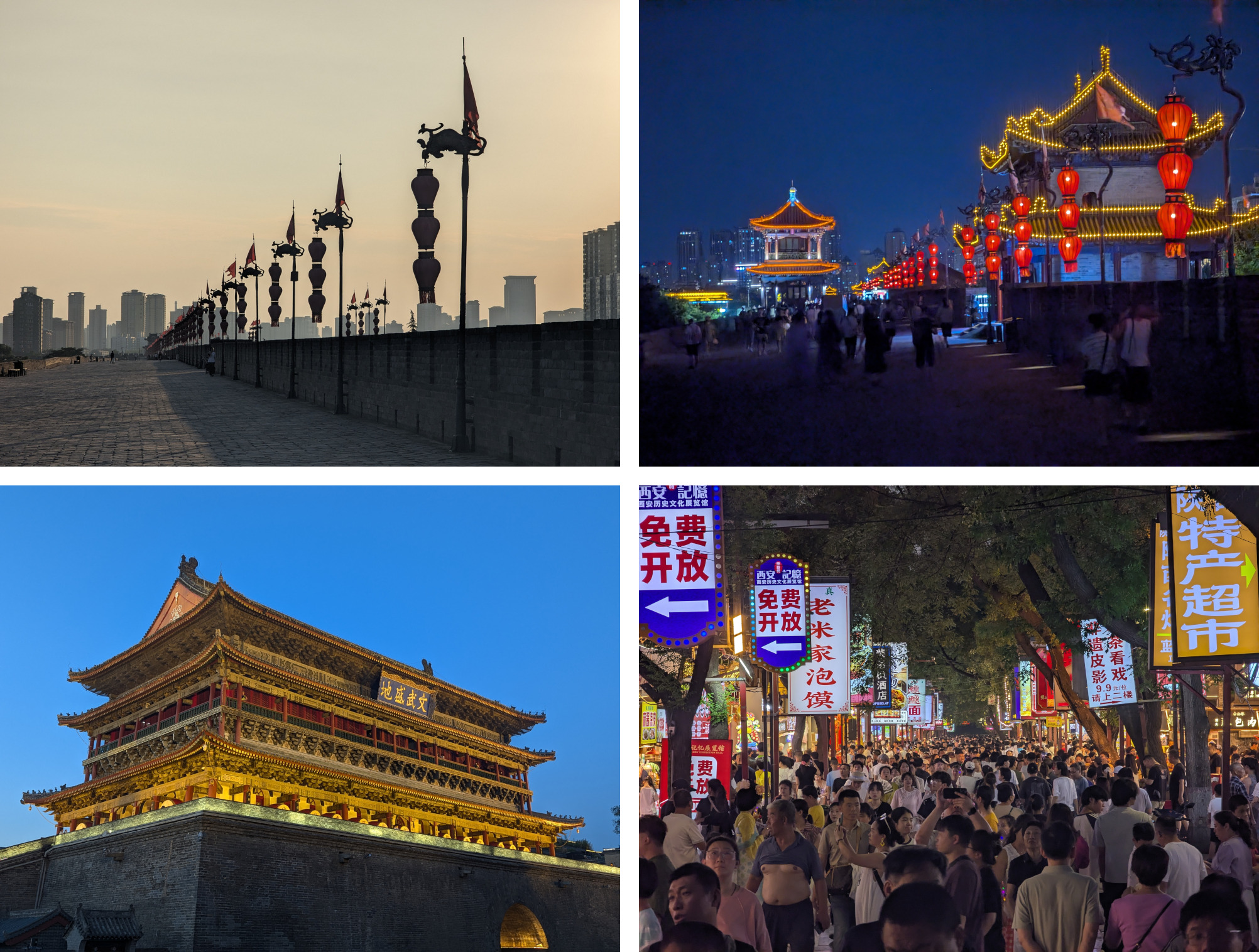
Clockwise: the Xi’an City Wall (x2), the Muslim Quarter, the Xi’an Drum Tower
I was really interested to find out that there is a Muslim area of Xi’an, as I was under the impression that China isn’t a big fan of religion. Walking through the area, though, it felt far more Chinese than it did Muslim - I didn’t see or hear a word of Arabic anywhere, nor see any Islamic symbols or architecture. I later found out that this is due to government regulations: while Arabic can be used during worship in the mosque, publicly displaying it is strongly frowned upon, even if it is next to its Chinese translation.
The next morning, I put on my long trousers for the first time in weeks to visit the Great Mosque of Xi’an. It was really cool to see a mosque with Chinese architecture, especially one founded barely 100 years after Muhammad died. More importantly, however, it was fascinating to see how possibly the most important Islamic site in China is treated by the government. A few small signs about Islam were dotted around the grounds, but these were dwarfed by huge red boards with Chinese flags and symbols, headlined with phrases like “always follow the Party” and talking about the importance of Chinese unity. Even within the mosque I struggled to find any Arabic writing besides an ancient stone tablet describing a calendar system (which was very cool nonetheless). That being said, the mosque was so peaceful and calm, and it definitely felt like a holy place.
After briefly returning to my hotel to change back into shorts, I successfully navigated Xi’an’s public transport system (two metro lines and a bus, first try!) to my main attraction of the day: the Terracotta Army. The level of detail in the 2,200-year-old figures is really unbelievable, but what I didn’t know and what I found the most incredible is what’s still under the ground. Not only has just 25% of the army been excavated, the actual tomb of the first emperor of China, Qin Shi Huang, along with the literal underground city that he had 700,000 people build over 40 years for him to rule over in the afterlife, all remain untouched. Pardon the pun, but we have literally barely scratched the surface.
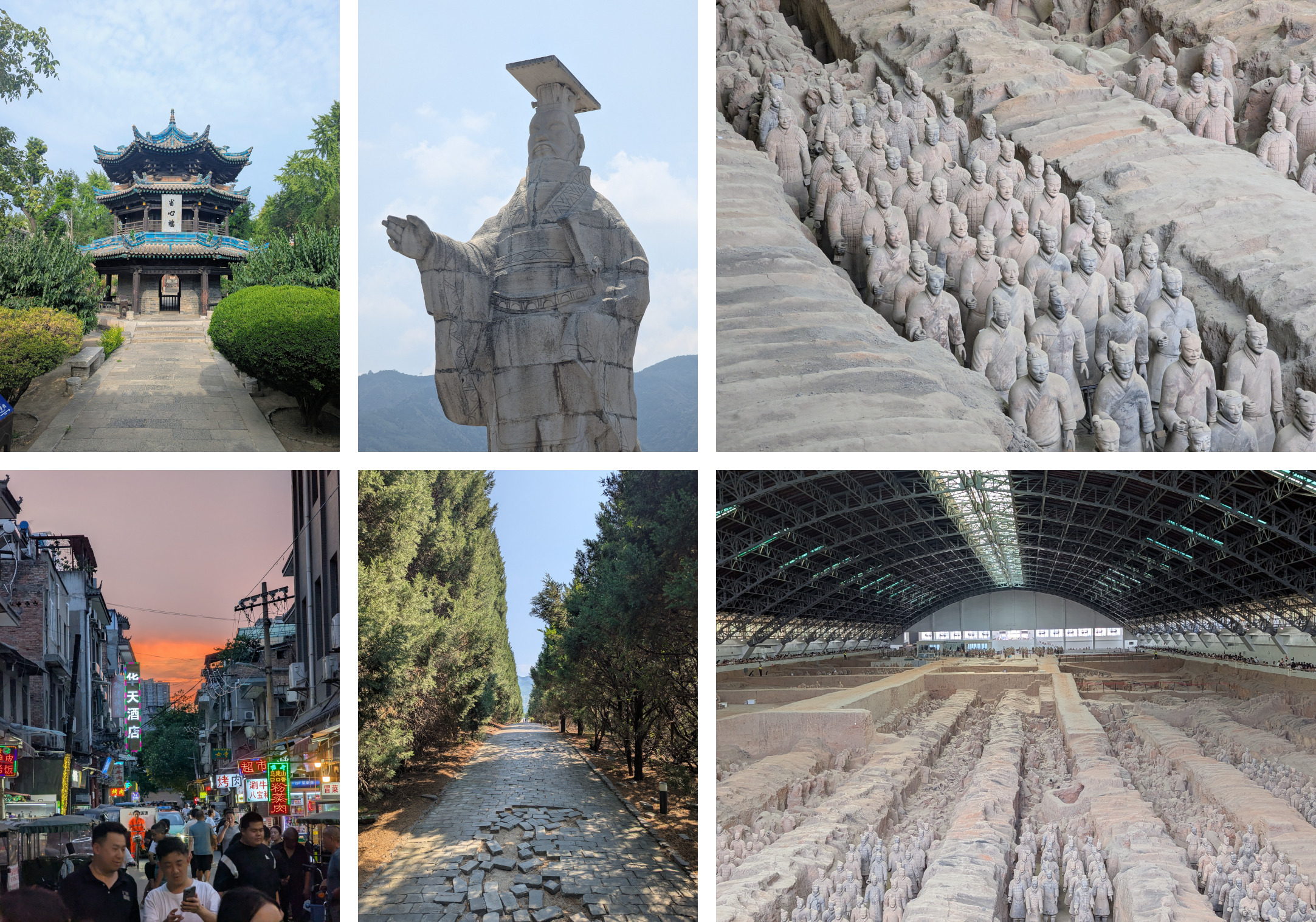
Clockwise: the Great Mosque of Xi’an, a statue of Qin Shi Huang, the Terracotta Army (x2), the park below which lies the underground city, a street in the evening
It was also my hottest day yet in China at 42 degrees with the brightest sunshine I’ve ever experienced. I made the mistake of thinking that because the Terracotta Army is inside, it would be fine, but I didn’t anticipate the amount of queuing in direct sunlight that would be necessary. I did have to take refuge in the corner of an air-conditioned room and chug water for half an hour to cool down at one point, but otherwise I survived (and didn’t even get sunburnt!).
I tried various kinds of street food for dinner, including roujiamo (delicious tender meat in flatbread), an octopus skewer (I was quite nervous about food poisoning but it was amazing and I’m okay so far), and deep-fried mushrooms, before returning to my hotel fairly early to sit down and properly plan the following week.
Despite spending very little time in Xi’an, it was one of my favourite cities on the trip. Compared to Beijing, the historic parts were more historic, the busy streets busier, and the food I think where possible even more delicious (I love the thick noodles so much, literally the perfect noodle). I’m struggling to describe the vibe in words - it had a very specific dusty ancient kind of vibe that I really liked. It’s definitely a place I want to spend more time in on my next trip to China!
成都 Chengdu
Up next on my trip was Chengdu, the capital of Sichuan province. After another easy few hours on the train, I found myself in yet another city that was completely unlike any of the others. In contrast to the ancient and chaotic Xi’an, Chengdu felt like a much more relaxed and modern city. That’s not to say it wasn’t busy and lively, nor that it was soulless and new, but the hustle and bustle felt like it came from a place of fun rather than necessity, and the modern developments didn’t overshadow the millennia of history that, like Xi’an, it still proudly embraces.
I began my time in Chengdu with a walk through People’s Park, a beautifully landscaped verdant park with a really lovely peaceful vibe. Little stone bridges spanned narrow channels of the meandering lake, huge green trees shrouding the paths in much-needed shade as I took my first steps in exploring the new city. I made my way up and out of the park to Kuanzhai Alley, a pair of old streets lined with teahouses, independent shops, and nowhere near enough trees for such a hot and sunny day, so when I was invited into a cool nearby restaurant, my guard was slightly down, and I didn’t think too hard about saying yes.
I followed the guy down a very dodgy back alley - if I had been in London I would without a doubt be imminently losing my phone and wallet at the very least - and into a completely empty restaurant that was, to put it nicely, desperately in need of renovation. I was moments away from turning around and walking right out again when this little kid appeared out of nowhere next to my table, and asked what I’d like to eat. I couldn’t possibly be so rude to a little kid, so I ordered the iconic Sichuan dish of mapo tofu (tofu in a spicy sauce) and hoped for the best. A few minutes later, a really nice old lady brought me my food, and it was one of the best dishes I’d eaten on the whole trip so far - very spicy but just about bearable, perfect texture, and incredible taste (and it was only £2.50!). As I walked out of the restaurant, full and content and with both kidneys intact, the guy and the kid and the lady, who were now quite obviously three generations of the same family, all running the restaurant together, were very eager to say goodbye to me and to thank me for coming to their restaurant, and I felt so guilty for judging it so much at the beginning.
By now, it was getting dark, so I walked down the beautifully-illuminated river and past a busker playing a lovely calm song about Chengdu. Little did I know that, over the coming few days, I would hear this song absolutely everywhere and all the time - it’s crazy that the city has such a ubiquitous “theme song”! I eventually ended up at the Anshun Bridge, a magnificent ancient-looking but actually-barely-older-than-me bridge in a happening part of the city. After exploring the area for a bit, I decided it was time to call it a day, so I headed back to the hotel to prepare for an early start the next day.

Left to right: People’s Park, delicious mapo tofu, me and the Anshun Bridge
To say the giant panda is a symbol of Chengdu is a vast understatement - it is an omnipresent inescapable motif that permeates every corner of the city, from panda-themed metro trains to panda statues to the logos of every city service. So, naturally, one of my most highly-anticipated destinations on the trip was the Chengdu Panda Base, a world-leading centre for panda breeding and research, and home to hundreds of the cute creatures. Since pandas don’t like the heat, I got there as it opened in the hopes of seeing some outside before they retreat to their nice cool air-conditioned houses (they really do live lives of luxury), and I was in luck! I’d never seen a panda in person before, and I somehow didn’t realise (here we go again) that they are actually just bears in a cool colour scheme. Incredibly lazy and relaxed bears, but bears nonetheless.
Having got to the base so early, I had seen everything by lunchtime, and as I was about to head back into the centre of Chengdu, something caught my eye. There, on the top shelf, in the far corner of the gift shop, sat an adorable bundle of fur and excess baggage fees, longingly begging me to bring him along on my trip. Rational thought went out of the window, and with no regard for the capacity of my bag or my wallet, nor the logistical inconvenience a 50cm tall (and wide, and deep) companion would bring me, I left the panda base with my new friend Xiaofu and a huge smile on my face.
After dropping Xiaofu off at the hotel to keep an eye on my things, I headed back out to see the Wuhou Shrine, a temple dedicated to the ancient Chinese warlord Liu Bei and his friends. On the way, I stopped at a little restaurant to have dandan noodles for lunch, another delicious Chengdu classic. The shrine was really pretty and historic, but the museum’s prerequisite knowledge about the Three Kingdoms period was slightly above my level so my main takeaway was that everyone was constantly conquering everyone else for a while and Liu Bei was particularly good? I was talking to my dad about it and he somehow found a great article about the lessons that 21st-century business leaders can learn from Liu Bei, which taught me far more than the museum and the Wikipedia article did, and provided very useful background knowledge for the following day (more about that in a moment…).
As the sun got lower in the sky, I spontaneously decided to visit the financial district in the south of the city in search of a beautiful skyline view. The pink and orange sky was just beginning to fade when I found what I was looking for, and I watched the end of a beautiful sunset over the modern glass towers before venturing towards them to try to find some dinner. As seems to always be the case, it wasn’t long before I came across a perfect restaurant where I ordered hui guo rou (twice-cooked pork, yet another incredible Sichuan dish), which was delicious but much much spicier than when I’ve had it in the UK! After dinner, I went back to enjoy the now-night-time view once more to conclude a fantastic and very full day, then headed back to the hotel.

Left to right: a panda, my new friend Xiaofu, a statue of Liu Bei, the financial district
Having had such a busy day the previous day, I intentionally had little planned for my final day in Chengdu. As I headed out to find some lunch following a much-needed lie-in, I realised that I hadn’t had one of the most iconic Chengdu dishes of all: hotpot. Initially, I felt a bit weird about having what is inherently a social dish alone, but my friends reminded me that there are loads of sad lonely people in China just like me, so it wouldn’t be weird at all (really reassuring words there). Despite wisely ordering the least spicy broth (and for the record, I really like spicy food), my eyes widened and promptly starting watering when they brought out the fire-red soup, rammed with more chillies than the entire UK’s annual consumption, already bubbling away and smothering my face with its pungent vapours. What I’m trying to say is that it was insanely spicy. All the dishes I ordered were really delicious, especially the meat - it just would’ve been nice to be able to taste it a bit more instead of having my mouth annihilated by copious amounts of capsaicin.
I spent the afternoon looking for a birthday present for my sister (no spoilers, but I’m extremely pleased with what I found) and dealing with my taxes (can’t escape it), before starting my evening off strong with the proper hardcore cultural experience of Sichuan opera. It was an absolutely fascinating experience and completely unlike Western opera in every way. One of its important components is face-changing, where the performers change their masks instantaneously, which was incredibly impressive to see in person and I’m still not entirely sure how it works - traditionally, it’s a top secret art passed down from generation to generation within artistic families. Some of the storyline featured Liu Bei and I was unreasonably proud to understand the most basic gist of what was going on!
Despite having an enormous amount of food for lunch, by the time the opera finished I was very hungry so I had yet another delicious classic Sichuan dish for dinner, Kung Pao chicken. I finished up my final day in Chengdu on Jinli Old Street near the Wuhou Shrine, enjoying the beautifully-illuminated lanterns, some great live music, and the relaxed Chengdu vibe.

Left to right: hotpot, Sichuan opera, Jinli Old Street at night
重庆 Chongqing
Having reached the westernmost point of my trip, it was time to head back east and into the mountains once more, this time to one of the most creatively-designed cities I’ve ever been to: Chongqing. When I think of a “city in the mountains”, I picture something like Hong Kong - beautiful green mountains rising up above the dense metropolis at their feet, a clear separation and mutual respect between nature and people. Chongqing doesn’t just blur this line, it erases it entirely - the mountains and the city are one and the same. You can climb from the base to the 20th floor of a building and still be on the ground. One second the metro train is deep under the surface, the next second it emerges upon a towering bridge, looking down from above on the huge skyscrapers now entirely below it. The whole city is an incredibly impressive feat of engineering, packed with modern buildings, creative infrastructure, and never-ending steps up the steep hills.
Chongqing was only a brief stop on my trip between Chengdu and my real mountain destination (more about that later), but I couldn’t go through it without exploring what is one of the most-hyped Chinese cities online at the moment. My first stop, of course, had to be the train that goes through a building. If you somehow haven’t seen the seemingly endless Instagram reels about this - of all the things China could be promoting this hard to the West I’m not sure why they chose this one - one of the metro lines (which is actually a monorail, which is very cool) goes right through the 8th floor of a residential building and out the other side. In fact, the entire 6th and 8th floors make up a train station called Liziba, and getting down to the exit at street level is quite the trek! There’s not really much more to say about it - it was pretty cool to see.

The train that goes through the building, going through the building
After accidentally ordering an enormous portion one of Chongqing’s most famous dishes, laziji (very spicy diced fried chicken), for dinner (it was amazing), I took a bus up one of the very few mountains not covered in concrete to watch the sunset over the skyline. A small traditional Chinese pavilion sat in a clearing near the top of the forested mountain, quietly watching over the sprawling city of more than 20 million people, not one of whom shared my stunning view. The sun went from white to orange to a deep red, slowly disappearing behind the sea of towers, before all of a sudden it was gone and its warm light was replaced with the blue glow of the illuminated cityscape. I was reminded of the incredible sunsets I enjoyed on Huangshan - this one couldn’t have been more different, but at the same time the peace and quiet in the fading light felt remarkably similar.
I wanted to walk down the mountain but quickly realised that walking a steep mountain path, that I’d never walked before, in the dark, was not my best idea, so I took the bus back into the city and went for an evening stroll down the river. At the bottom of the nearly endless steps leading down to the riverbank was possibly the last thing I expected in such a built-up major city: a huge sandy beach, full of people enjoying the view and paddling in the water. I walked down the beach towards the enormous bridge spanning the river valley in the hopes of getting onto the bridge and across to the other side, and from directly below the bridge to on top of it ended up being a 40-minute walk! Eventually I made it across the water to the heart of Chongqing, where I had xiaomian, a traditional Chongqing-ese (I’m running out of ways to say “this dish is from this place”) spicy bowl of noodles, for a delicious late-night snack before finally getting back to the hotel just as all the buildings were turning their lights off.
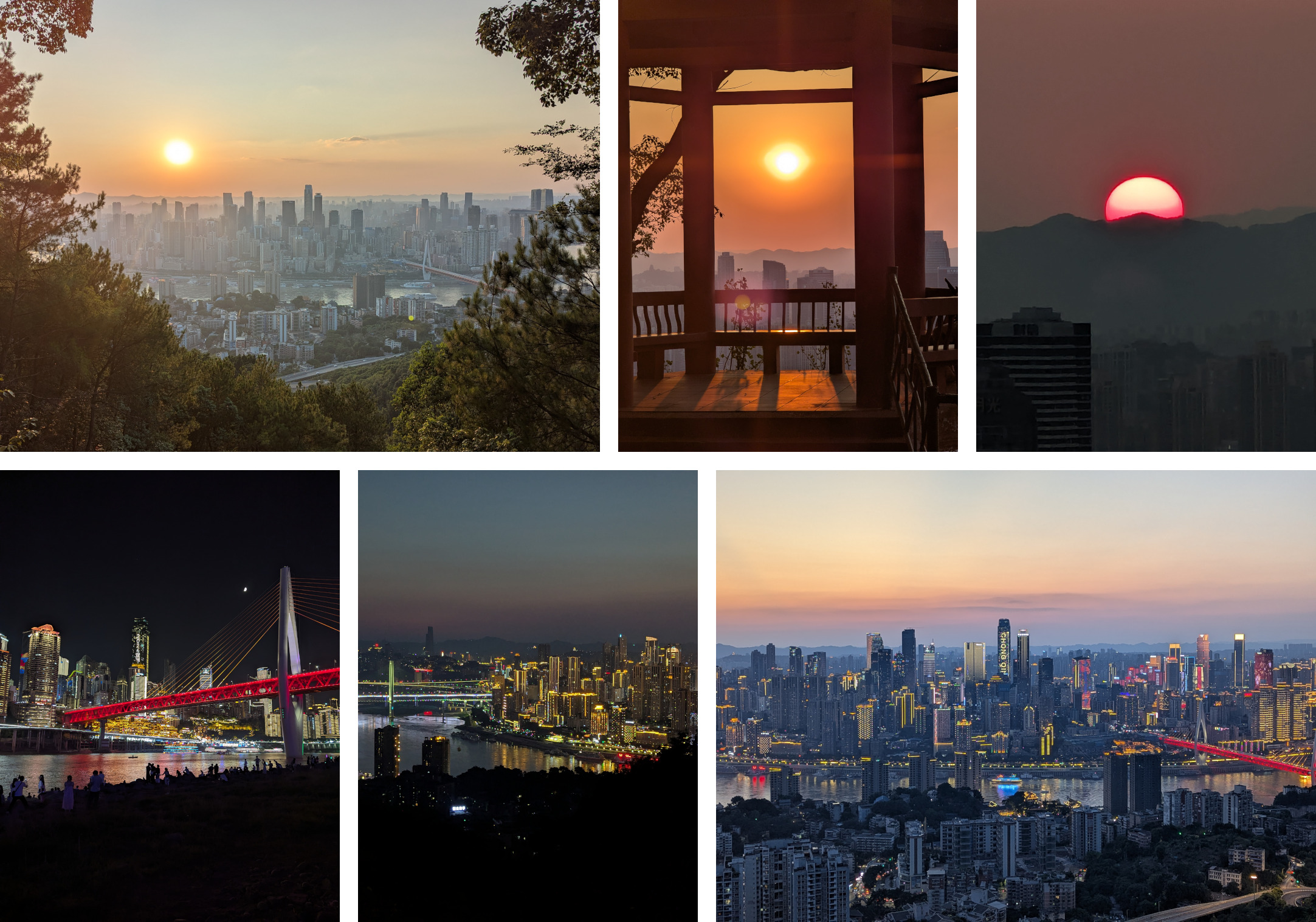
Clockwise: the beautiful sunset (x3), the skyline at night (x2), the beach
The next day I had a nice slow morning, getting up late and wandering the shady yet sweltering streets of Chongqing before xiaomian again for lunch (because the menu was inaccessible for pointing and it was the only dish that I could confidently pronounce), which was again delicious. I continued exploring at a slow pace in the afternoon and bought some presents for my parents, and it was really nice to have the chance to relax a bit and not be rushing around every single day! That being said, some rushing around was still necessary, as in the evening I had the fun challenge of navigating the newly-opened, insanely huge Chongqing East train station (Asia’s biggest!) to get a train to my real mountain destination.
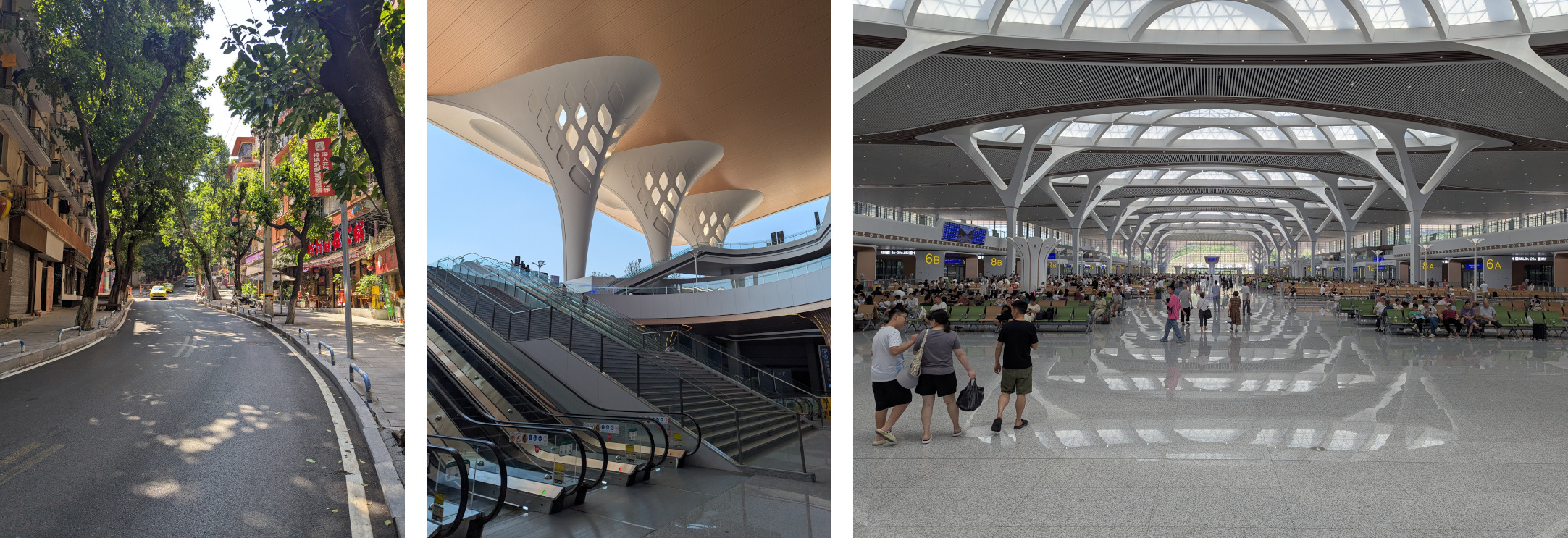
Left to right: a pretty Chongqing street, Chongqing East train station (x2)
张家界 Zhangjiajie
My train arrived after the last bus towards my hotel left, so I booked a taxi through the Didi app, much to the displeasure of the hordes of people trying to usher me into their cars. Half an hour of liberal horn usage later, I reached Wulingyuan, an immensely touristy yet still surprisingly nice town at the entrance to the national park and, after a quick dinner, went straight to bed in preparation for an early start the next day.
Shortly after sunrise, I was back up and out and on my way into the mountains. I was expecting it to be busy, being one of China’s most popular tourist destinations, but nothing could have prepared me for the ridiculous crowds I had to fight my way through in order to see anything or go anywhere. The whole national park was designed around a network of tourist buses, ferrying people between overcrowded viewpoints where they would battle their way to the front to take a photo before getting back onto a bus and doing it all over again. This rushing torrent of tourists was nearly impossible to escape, and, after being swept onto two buses against my will, I was genuinely ready to call it a day and go home.
Then, as I was desperately trying to row against the tide, I saw out of the corner of my eye a narrow, overgrown, and absolutely perfect little path heading into the dense forest. Like finding an oasis in the desert, I was overcome with relief as the noise of the crowds faded away and was replaced with the buzzing of intimidatingly-large bugs and the singing of birds. To say it was an incredible walk would be an understatement - the almost empty path wound up and down the sandstone peaks, traversing lush forests, rocky outcrops, and precarious cliff paths as it slowly made its way down the mountain to the bubbling stream at its foot.

Left to right: sunrise, Yuanjiajie, a particularly perilous outcrop
After reaching the end of the trail, I continued along the valley to another mountain, climbed all the way up it, ate a delicious pancake at the top, and then climbed back down the same way because the path down the other side was closed. Along the way, I encountered some wild monkeys which were absolutely terrifying - like a bully in the playground trying to be intimidating, this tiny monkey jolted towards me as if about to beat me up, and I have literally never been so scared in my life. I very quickly left its territory without looking back, and fortunately the only thing hurt by the time I got home was my pride.
After such an eventful day, I was very hungry by the time I got back to Wulingyuan, so I went out in search of one of the most famous dishes from Hunan province: hong shao rou (red braised pork belly), supposedly one of Mao Zedong’s favourites. It was absolutely incredible, one of the best meals I had on the trip, and I will never be able to enjoy it again in the UK!
I began the next day by accidentally buying a boat trip on a lake. I thought I was just paying to enter the national park, but somehow I ended up being herded onto a boat to go for an unexpected but really fun cruise around the beautiful lake. While I struggled to appreciate what I’m sure was very valuable Chinese commentary, it ended up being a great relaxing start to the day.
What I HAD planned to begin my day with, and what I promptly got to after getting off the boat, was to hike a little-known trail to Yingwo Village, a secluded mountain dwelling built into the side of a cliff, once a bandit stronghold. I think it was one of the best hikes I’ve ever done - the route took me up a verdant narrow gorge, the occasional lucky ray of sunlight just barely squeezing through the dense green forest and towering mountains to make a little shimmering pool of light on the ground, before the path suddenly opened up with sweeping views of the landscape. Then it was back down into the forest, winding around rocky cliffs before I unexpectedly stumbled across an amazing ancient temple in a tiny clearing, surrounded by mountains on all sides. I took a moment to enjoy the incredible still and quiet, the only sound being the gentle humming and chirping of its inhabitants, and then continued onwards to Yingwo Village. It was quite eerie - the cliffside houses definitely once had working electricity, and whilst they were now very overgrown, it took surprisingly little imagination to see the bandit hideout they once were. The trail ended by a magnificent waterfall, and I headed back into town to do laundry and prepare for a long day of travelling the next day.

Left to right: the lake, the gorge, the temple, the waterfall
While the touristy parts of Zhangjiajie were horribly overcrowded, once I got off the insanely-well-beaten track, the hidden mountain paths were remarkably peaceful and provided some of the most incredible scenery of the whole trip. After a fairly long streak of cities, it was so nice to get back out into nature and enjoy the unbelievable Chinese landscape that you really can’t get anywhere else. And I wasn’t done yet with the countryside, because it was time for two more unique landscapes before my next big city!
龙脊梯田 Longji Rice Terraces
I was really enjoying the freedom of not planning the trip too far ahead, but, perhaps predictably, I eventually flew too close to the sun. By the time I got around to booking this time, every single seat on every single train was taken, so what should have been a nice simple direct train followed by a single bus turned into four trains, a night in a train station hotel, a bus, a taxi because I took the wrong bus and ended up in the middle of nowhere, and another bus. However, all this inconvenience gave me a great opportunity to see another side of China: the one that regular people see.
Up until this point, I had only taken high-speed trains, which are good value by UK standards but incredibly expensive for many people in China - a return journey from Beijing to Shanghai and back by high-speed rail costs a month’s wages for the median rural household. With all the high-speed trains I could have taken for several segments of the journey fully booked, I took some regular trains for the first time, and the difference was unexpectedly stark. While the high-speed trains feel fairly similar to high-speed trains in Europe (maybe with slightly more legroom) the regular trains were like nothing I had ever experienced before. Stepping through the thick haze of cigarette smoke just inside the door, I squeezed my way along the old, crowded, dimly-lit carriage towards my seat, which was taken by an older man who was fast asleep. Not wanting to disturb him, I wandered further along the train until I found a tiny corner of a seat to perch on beside a guy who didn’t look particularly thrilled to have lost his extra space. The vibe on the train was fascinating - there were people doing everything from playing lively card games to sleeping soundly, all sitting literally shoulder-to-shoulder.
On one of the trains, two small children came and sat next to me and, despite the language barrier, we actually managed to have a pretty lengthy conversation. They had a huge bag of various Chinese snacks and were having great fun getting me to try all of them, which was very generous (even if I was really, really full by the time I got off the train!).
Eventually, after a very long and complicated journey, I arrived at the Longji rice terraces. Wisps of cloud drifted along the steep river valley, providing much-needed rain for the endless rice terraces that lined the mountain slopes. Little wooden villages, home to the native Zhuang people who have farmed rice here for more than 600 years, were dotted among the hills, with narrow mountain paths and trickling streams racing each other down to the gushing river below.
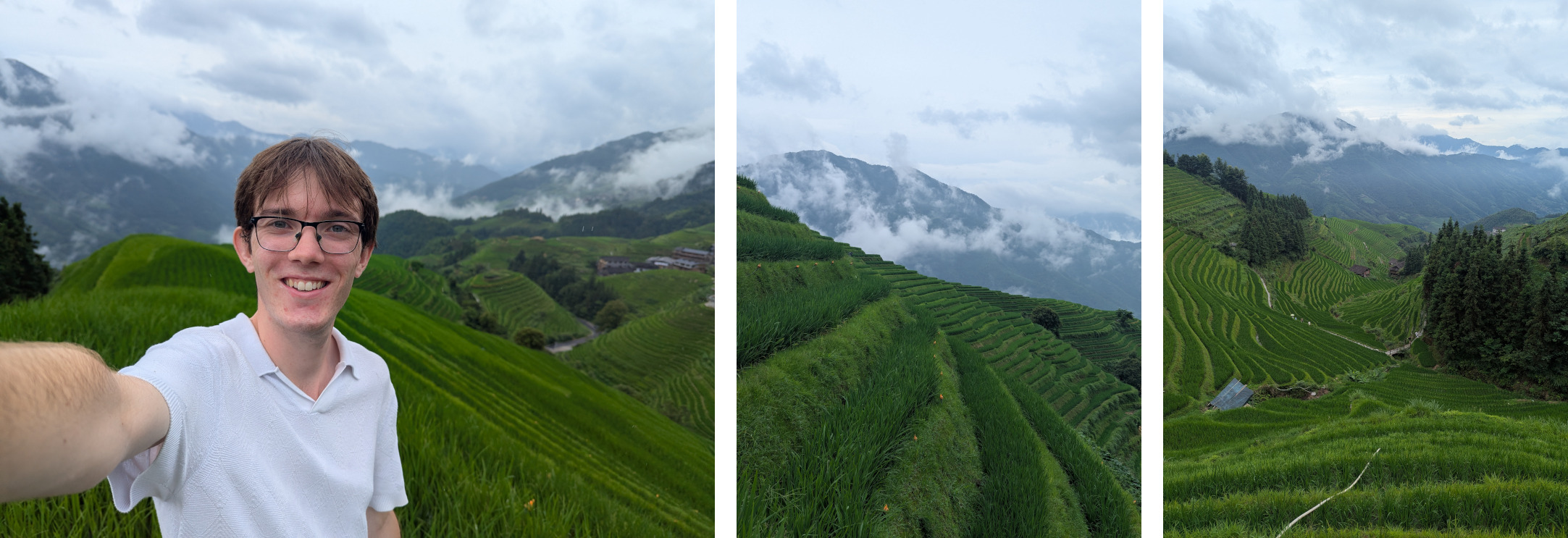
The Longji rice terraces at a village called Ping’an
Many cultural attractions that I’d been to earlier in the trip felt like the cultural aspect, while fascinating and often very well-preserved, had been left behind in history, so it was an amazing breath of fresh air to finally visit somewhere historic that still felt alive. The fields were full of local people tending to the crops, wearing those iconic conical hats that I half thought weren’t even a real thing, carrying heavy buckets of things over their shoulders up and down the mountainside. It was great fun and so relaxing to wander through the fields and between the villages in the cool mountain breeze, and I found myself wishing I was able to spend more time there.
阳朔 Yangshuo
Another wrong bus, ten perilous miles on a moped, one stop on a train, and a plate of pig ears (I got overconfident with my Chinese and thought it said pork belly) later, I reached the breathtaking and unique landscape of Yangshuo. Wide rivers full of wooden boats politely meander around the towering cliffs of limestone which protrude from the verdant plains.
My first order of business would usually, of course, be to climb up the tallest mountain I can see, but the sheer sheerness of the cliffs made that quite a challenge. Eventually I found a steep, narrow, slightly-secret-feeling path up a densely-forested mountain, and a short but intense climb later, just as I was approaching the summit, the increasingly spectacular view I had been enjoying on the climb was blocked by a large red sign. The sign, alarmingly complete with English translation, informed me that I was trespassing in a restricted area under national security law, and that I was probably about to disappear and never be seen again. Not hugely liking the prospect of being convicted of espionage, I made a rather rapid descent of the mountain to spend the afternoon accidentally breaking another law.
All around Yangshuo, I had seen several people offering mopeds to rent, but I had assumed (spoiler: correctly) that I’d need a driving licence, which I don’t yet have. However, a particularly enthusiastic guy assured me I didn’t need one, so I paid my £3 and sped off into the countryside at what I later found out was triple the speed a moped can legally go without a licence. As the sun began to set over the unbelievable topography, I drove along the Yulong river with the wind in my hair (sorry dad) feeling so incredibly lucky to have the opportunities to do such amazing things. I found a tiny outdoor restaurant by another river where I sat down and ate dinner under the setting sun, before returning to Yangshuo in the dark to finish my day by falling into a river (the pavement randomly ended and was replaced by a metre-deep ditch into which I confidently walked). Miraculously, my phone, which doesn’t work at all in light rain and got completely submerged, still worked, and the relatively minor damage to my knee was nothing compared to the devastating mutilation of my pride and the extreme aura loss of falling into a river right in front of a large crowd of people.
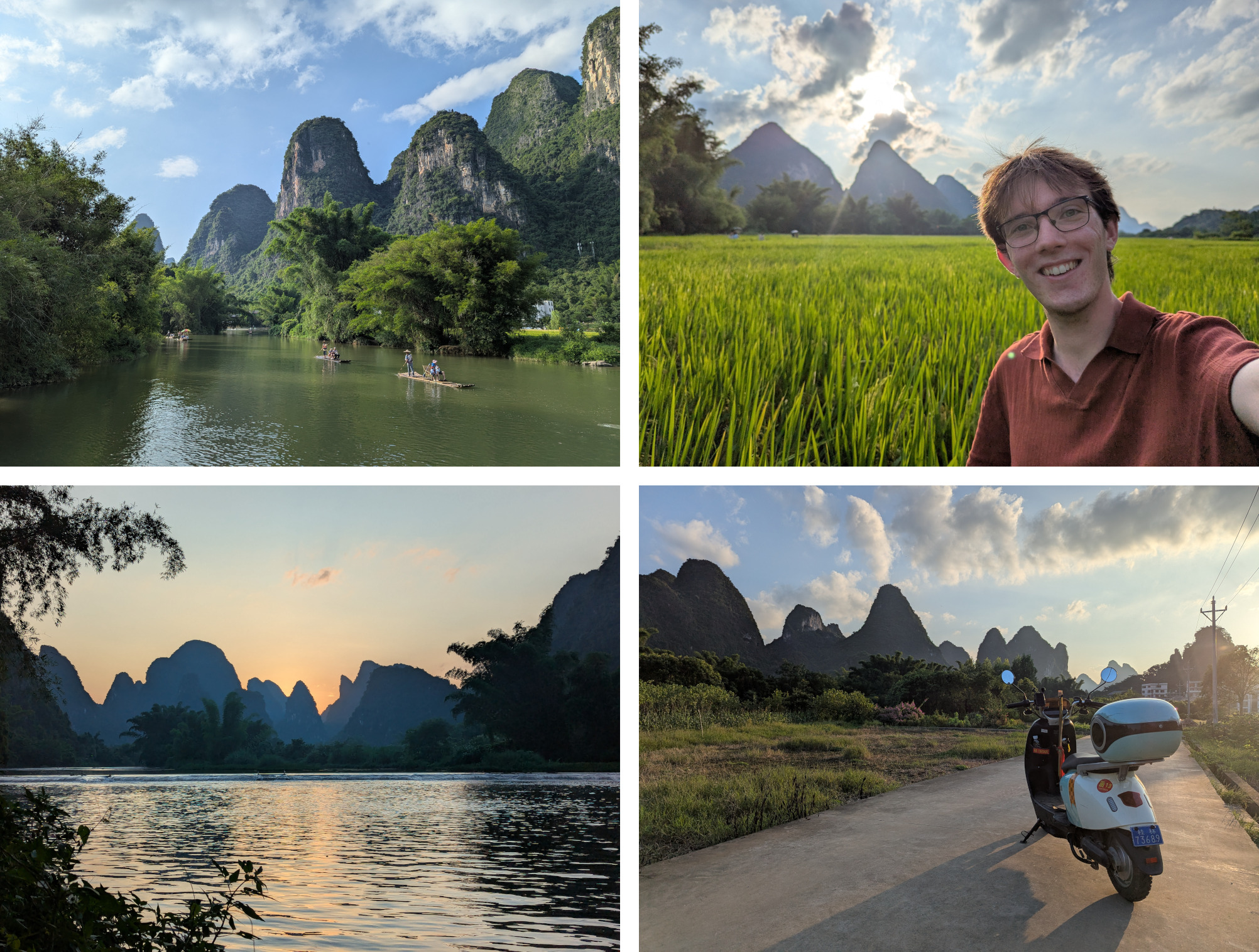
Clockwise: a bridge over the Yulong river, me in a field, the moped, sunset view from my table at dinner
The following day, I got a bus up to Xingping, a town further up the Li river, to go for a long walk in the countryside, hopefully ending up at the popular Xianggong Mountain. I made the mistake of trying to take a shortcut suggested by a dodgy map I’d found online, which got narrower and narrower and more and more overgrown until I remembered there were probably snakes and stuff in the long grass I was trampling, so I gave up and went the long way. As I made my way up the completely empty road in the middle of nowhere, I saw a little moped coming over the horizon, and to my surprise there was a random Dutch guy driving it, so we had a great little conversation and he recommended I climb another mountain that was sort of on the way.
It was still fairly early in the afternoon, so I took his advice and began the unexpectedly long climb up the mountain, which was absolutely 100% worth it! There was an incredible panoramic view of the whole area from the top, and as I was enjoying the view I met a Chinese guy who I actually managed to have quite an involved conversation with in Chinese (augmented with plenty of gesturing). I told him about my day so far and the mountain I planned to climb next, and he told me that I should climb a different mountain instead because it has the most amazing sunset views in the county. Realising that sunset was in less than four hours, and that that peak was probably at least a three-hour walk away, I thanked him for his suggestion and promptly began my new quest to see the sunset.
The final part of the climb was a proper scramble, with a few ladders here and there to help out. I reached the rocky outcrop at the top just as the sun was nearing the horizon, and was greeted by yet another breathtaking view, something I was beginning to expect in China! A few boats were still out traversing the twists and turns of the river, the water cast in shadow by the mountains above, and for maybe the first time on the trip I noticed huge flocks of birds in the sky, enjoying the cooler evening air. The sun slowly dipped below the hills, and I suddenly realised that I was going to have to do this difficult climb again, in reverse, in the dark. Fortunately, I made it down alive with the help of my phone torch, but it was the first and only mountain I’ve ever climbed that took me longer to get down than up.
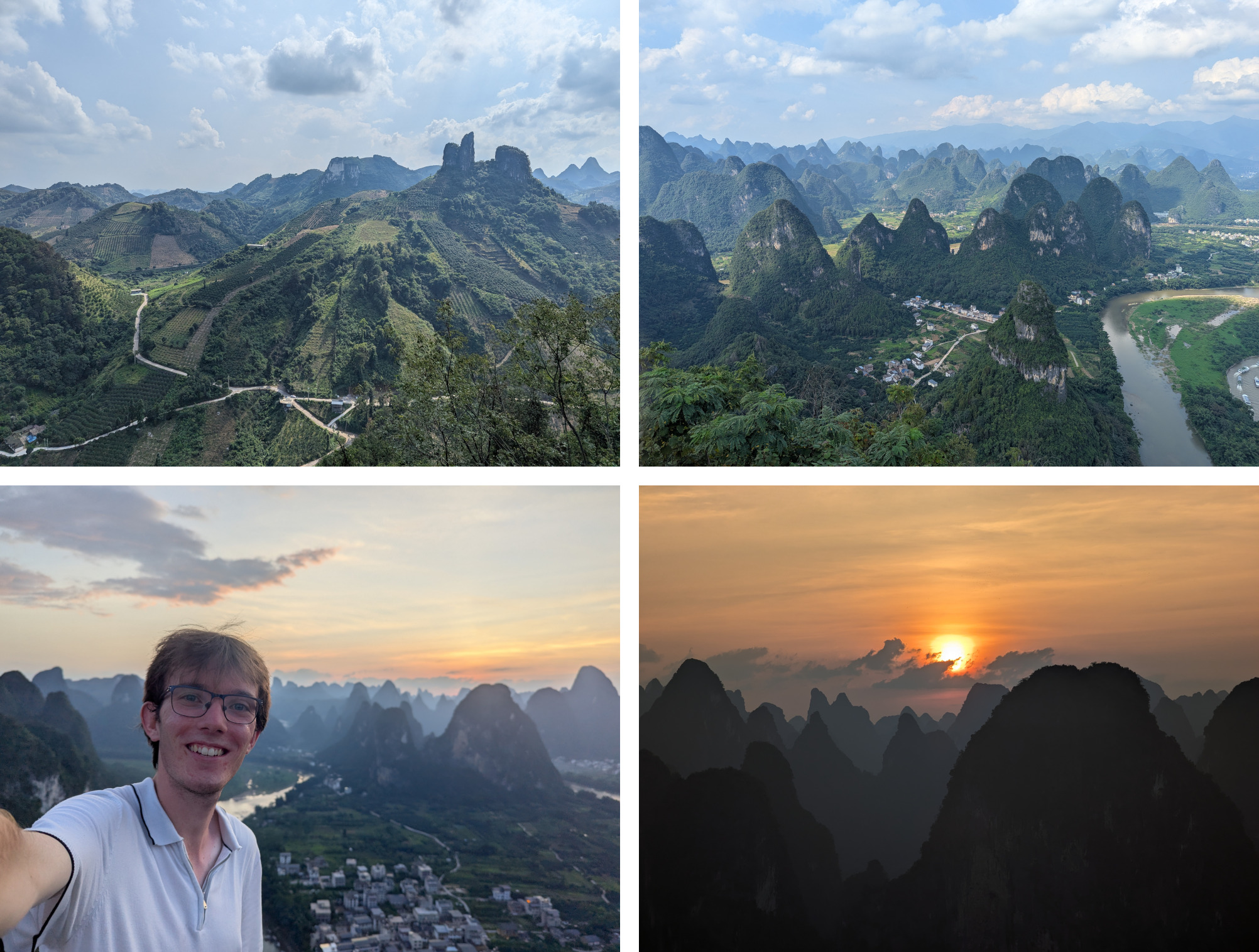
Clockwise: the view from the first mountain (x2), sunset from the second (x2)
I began my final day in Yangshuo by trying a local delicacy: beer fish. Fresh fish caught in the Li river, braised in a sauce based on local beer, plus plenty of ginger, garlic, and other delicious vegetables - it was another culinary highlight of the trip. In the afternoon, I rented another moped and explored some more beautiful rural villages, flying through the fields without a care in the world or an awareness of the rapidly-depleting moped battery. Suddenly, ten miles from home, I got a flashing warning light. Once able to cruise uphill at 60km/h, the moped soon struggled to maintain 10km/h on the flat, and as the daylight faded I began to dread the seemingly-inevitable night-time trek pushing the heavy lump of metal back to my hotel. As the moped breathed its last breath crawling over the top of a hill barely halfway home, I beheld the most miraculous sight: four miles of continuous downhill. Modern engineering might have failed me, but the fundamental forces of the universe weren’t going to leave me behind. I eventually made it back to the town with only minimal pushing required, returned the moped, and went straight to sleep after a surprisingly tiring day.
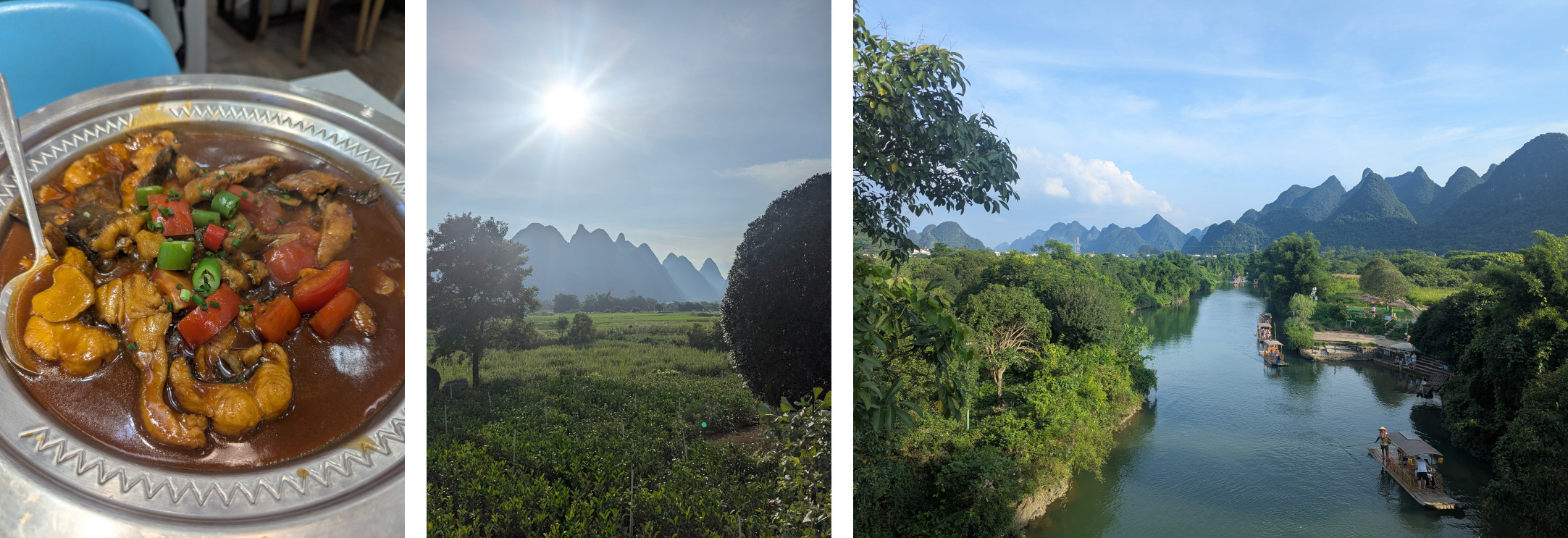
Left to right: beer fish, more beautiful views (x2)
深圳 Shenzhen
After almost a week in the countryside, it was time to get back to civilisation, and where better to finish off the mainland part of my trip than Shenzhen, the Silicon Valley of China and yet another city with a completely different vibe to any of the others. The whole city is brand new, crammed full of shining glass towers with traditional architecture nowhere to be seen, yet somehow it feels just as distinctly Chinese as anywhere else I went in China. The layout of the city, despite being designed from the ground up in the 80s, echoes traditional Chinese city planning of centuries past with its perfectly-aligned hierarchical roads, extremely satisfying symmetry, and unambiguous central point.
My first afternoon in Shenzhen was spent exploring the centre of the city, dodging autonomous street sweepers as I made my way towards Lianhuashan, the hill at the top of the city’s central north-south axis, where I watched the sunset over Deng Xiaoping’s capitalist utopia next to the man himself. Following some delicious wonton soup for dinner, I walked a few miles down the seafront in the warm night, the twinkling lights of Hong Kong across the water reminding me that this first part of my trip was drawing to a close. With less than 48 hours remaining of my visa-free entry to the mainland, the next day would be my last this side of the border, but I was most certainly going to make the most of it.

Left to right: the skyline from Lianhuashan, a statue of Deng Xiaoping (whose policies made Shenzhen what it is today), the Ping An Finance Centre
I began my final day in the mainland by climbing the highest mountain in Shenzhen, Wutongshan. Had this been at the beginning of my trip, I don’t think I’d have even made it halfway, but with almost a million steps on Chinese soil behind me by this point, I made it to the top in less than half the signposted time. The trail crept its way up the mountain alongside a cute little forest stream, and despite being DeepSeek’s most highly recommended route, I didn’t come across a single person until the summit, where a huge crowd had gathered to partake in the traditional Chinese ritual of queueing up to all take the same identical photo. I didn’t feel the need to join in this time (the angle was really not all that special), so I made my way along the ridge, enjoying incredible views over the mountains of Hong Kong, and I finally began to recognise some of the mountaintops on the horizon as places I’d been before.
Before I could revisit them, though, I had one last stop in Shenzhen. The sprawling electronics markets in the city are some of the most impressive and important in the world - any technology you can think of can be found fresh from the factory at its lowest price, with the newest innovations popping up for sale in the Huaqiangbei district well before they catch on elsewhere in the world. Walking through the endless crowded corridors filled with the latest technology, my preconceptions about the US being the magical source of all innovation were proved more and more naive with every turn. I saw electric cars and bikes and scooters, tiny drones that can lift people, solar-powered phone cases, and millions of other amazing things, all designed and built and sold within just a few square miles.
That’s not to say that Shenzhen doesn’t have a dark side too. It’s well known that if your phone gets stolen in London, it’ll most likely end up in Shenzhen to be resold or, if it’s ID locked, be taken apart and used to repair other phones. Walking around the markets, the investigative journalist in me suddenly awoke with an idea for a great story: I would track down a British iCloud-locked iPhone, bring it back to London, and give it back to its owner. My starting point was a great Financial Times article which conveniently name-dropped a specific building to begin my hunt. I should’ve known it wouldn’t be that easy, though - since the article was published just months ago, the whole building had been cleaned up, the majority of the traders gone, and those that remained were doing business under huge signs warning that only unlocked phones of verifiable origin would be traded.
That didn’t deter me. I ventured down increasingly dodgy streets and alleys, searching for any hint of the supposedly vast underground market for stolen phones. Eventually, I found what I was looking for. A nondescript concrete tower block, one among millions, with the upper floors full of aggressive haggling, suffocating cigarette smoke, and, most importantly, literal mountains of phones, piled up metres high, with traders from all around the world digging through them and negotiating deals. Just as suddenly as my inner investigative journalist had awoken, he fell right back asleep, and I realised that I was actually far too scared (and illiterate) to make a deal here. I also discovered that bringing stolen goods back into the UK can get you 14 years in prison, so I made the smart choice to call it a day - now more than ever I am loving my freedom!
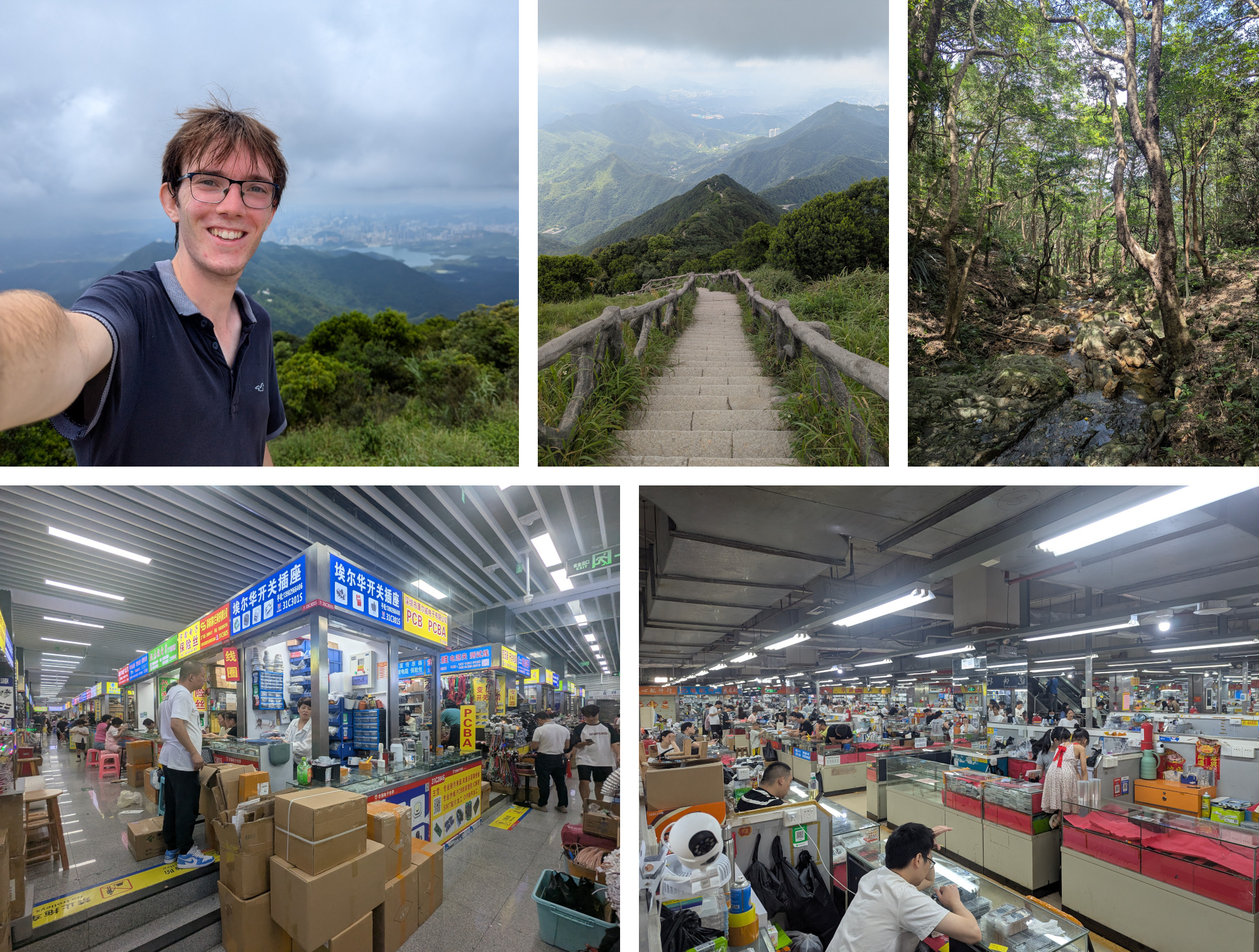
Clockwise: the view from Wutongshan, the stunning ridge, the stream, an electronics market of questionable legitimacy, an electronics market of slightly less questionable legitimacy
With that, I went back to my hotel for my final night in the mainland. I wish I could say I was reflecting deeply on my Chinese adventure, or that I was putting together wise philosophical thoughts, but I was actually completely exhausted and looking forward to a bit of a lie-in before the short walk across a bridge (yep) to Hong Kong.
香港 Hong Kong
It’s crazy how much walking across that bridge into familiar territory felt like “coming home”. After a month of a completely different culture, seeing the British road signs and the cars on the left, hearing people speaking English, going to places I’d been before - it was quite a surprise how immediately different and far more familiar it felt. I’d been to Hong Kong once before, and I remember it feeling so foreign then, but with my newly-calibrated foreign-ness scale, it almost felt like home.
I spent more than a week in Hong Kong and I took it a bit slower, so I’ll drop the chronology for this section and split it into two broader sections: nature and culture. (but first some iconic views)

Clockwise: me and the harbour, the view on the way to Victoria Peak (great hike), the sun setting over Central, the harbour lit up at night
大自然 Nature
Last time I was in Hong Kong, I barely scratched the surface of the incredible landscape around the city, so this time I made it one of my top priorities to spend a lot of time exploring the amazing scenery. As cities go, I think Hong Kong is pretty much the best one in the world for hiking, and I definitely made the most of it! In just two days, I climbed the five highest peaks in Hong Kong (with varying visibility from the summits), which was one of the highlights of the trip.
I spent the first of the two days on Lantau Island, where I took the cable car to the Big Buddha (it’s really big and really cool) before hiking onwards to Lantau Peak, the second-highest peak in Hong Kong and its highest publicly-accessible point. The trail was fantastic, with sweeping views nearly 1000m down to the sea on both sides of the mountain, and just that hike alone was almost enough to make me seriously consider moving to Hong Kong. I continued walking down the other side of the mountain and up the next one, Sunset Peak, Hong Kong’s third-highest and supposedly great for sunset views (although I wouldn’t know, the peak was in such dense fog I couldn’t see the end of my nose and I did actually text my dad my location just in case I was about to become another “British tourist” news story).
The weather was even worse the second day, but that didn’t stop me climbing Tai Mo Shan, the highest mountain in Hong Kong, alongside Sze Fong Shan and Miu Ko Toi, two of its sub-peaks (and numbers 4 and 5 respectively) that I worked into my route. Despite no views at all, I felt extremely accomplished, and on the way down the mountain I stumbled across some incredible waterfalls, which more than fulfilled my daily quota of beautiful things to look at.
Other mountains I climbed on other days include the iconic Victoria Peak, High West (I ran there from Victoria Peak to catch the sunset, and it did not disappoint), and Lion Rock, which was the highlight of my first trip to Hong Kong, and was even better the second time. I also paid a quick visit to Checkerboard Hill, a remnant of the old Kai Tak airport, which was such a cool piece of history to see.

Clockwise: the view from Lantau Peak, a very happy me on Lion Rock, the view from halfway up Sunset Peak below the fog, sunset over Lantau Island from High West
Mountains aren’t the only nature in Hong Kong! I also had an amazing walk down the Dragon’s Back trail to a beautiful beach at Shek O, where I went for a lovely short swim, got devastatingly sunburnt exclusively on my shoulders, and took the same bus back and forth three times because I kept missing my stop (I hate green minibuses).
Despite doing all of this, there’s so many more incredible trails to hike, beaches to swim, and mountains to climb - as with seemingly everywhere I visited, I could easily have spent months properly exploring. Maybe I’ll get the chance in the future, Hong Kong does seem like an extremely cool place to live…
文化 Culture
It’s not just the amazing landscape that makes Hong Kong a cool place to live, though. Possibly its greatest appeal is its culture, a fascinating blend of East and West, developed over its centuries of complicated and at times contentious history. And where better to learn about this history than the Hong Kong Museum of History?
Well, as it turns out, pretty much anywhere else. The fresh sea breeze must have got to my head, because it completely didn't occur to me that the government-funded Hong Kong Museum of History might have something of an agenda to promote, and that's putting it lightly. Nowhere in the mainland did I see any propaganda that came even remotely close to the egregious exhibitions at the museum - you're telling me I'm supposed to watch videos of the police beating up protestors fighting for democracy and see the police as heroes? The main exhibition was about the national security law and how it saved Hong Kong, complete with the biggest Chinese flag I saw on the trip and the literal batons police beat protestors with, while other smaller exhibitions revealed how Britain was entirely evil in every way and how Chinese immigrants single-handedly built modern America. I didn't hear a single visitor to the museum speaking Cantonese, and every room had several security guards keeping an eye on people's reactions to the exhibits - I was completely unprepared for just how intentionally provocative the museum was, and it genuinely frustrated me a lot (but I locked in in order to not get arrested). I think my visit to the museum had the opposite of the intended effect on me though - I went in eager to learn about the history of one of my favourite cities, and I left ready to join a pro-democracy protest!
After my very exciting trip to the history museum, I went to the Hong Kong Museum of Art to relax a bit and see some beautiful and ancient paintings. Just like in Shanghai, there was a great collection of amazing Chinese paintings, but unlike in Shanghai, the museum was right by the harbour with a fantastic view too! They had really nice prints of some of the paintings and I really wanted to get one, but unfortunately I’m not sure Xiaofu would have taken kindly to sharing his very limited bag space with a crumple-prone piece of card.
As well as museums, I also visited Wong Tai Sin temple, a busy yet beautiful Taoist temple, a clearing in the concrete jungle of Hong Kong. It was incredible that despite being absolutely inundated with tourists, almost all of them were there to pray! Behind the ornate main area, a quiet and beautifully-landscaped little garden provided some much-needed respite from the hustle and bustle of Hong Kong, with bubbling fountains, elegant pavilions, and fish dancing in the shadows of the surrounding tower blocks.

Clockwise: the history museum, the art museum (x2), Wong Tai Sin temple (x3)
Hong Kong’s incredible blend of Eastern and Western culture is pretty special, but it’s not entirely unique. Just across the bay lies Hong Kong’s often-forgotten and far better behaved little cousin, a former Portuguese colony and now the most densely populated territory on the planet, Macao. Being so close to Hong Kong, I got the ferry there for a day, and it was an even more interesting place to visit than I expected.
The old centre of the city looks and feels wholly European, far more so than anywhere in Hong Kong, with its colourful Portuguese architecture, ornate churches around every corner, and paved squares lined with bakeries, cafes, and… temples? Portuguese and Chinese cuisine meet in its many restaurants to make something altogether new and altogether delicious - Portuguese chicken (unintuitively a traditional Macanese dish) was a highlight. Then there’s the gaudy strip of casinos, seven times more profitable than Las Vegas, and the only place in China where gambling is legal (although the mainland is definitely not missing out on anything!). The strange combination of Chinese culture, Portuguese culture, and gambling makes for a really weird vibe, but a fascinating one nonetheless, and I really enjoyed my day of wandering around the streets, eating food, and not gambling.
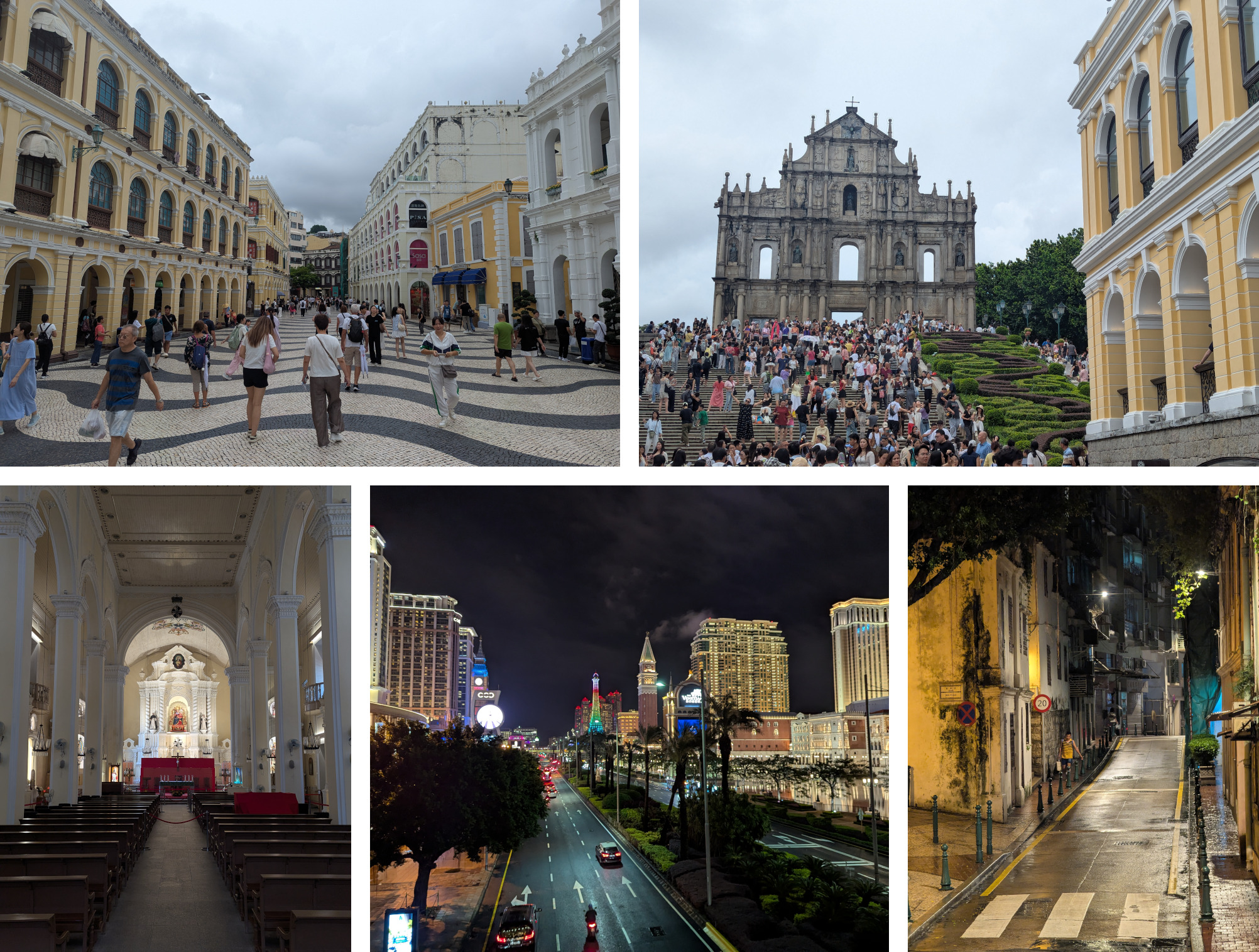
Clockwise: Senado Square, the ruins of St Paul’s, a Portuguese-looking street at night, the Cotai Strip, one of the many beautiful churches
Of course, my trip to China wouldn’t be complete without experiencing some modern Chinese culture too. Remember all the way back in Beijing, when I sat in the Forbidden City refreshing my browser for an hour to get tickets to a concert? Neither do I, that was 10,000 words ago, so let me remind you.
While I was in Beijing, my favourite Chinese singer, GEM, announced an unexpected additional concert in Hong Kong as part of her world tour, because the first four concerts had sold out months back within minutes of tickets going on sale. I hadn’t even fully committed to going on the trip back then, but when the extra concert was announced I knew with absolute certainty that I was going to be in the right place at the right time. The stars had aligned for me to go to this concert, so all that remained was to actually acquire a ticket. Which brings us back to the Forbidden City in Beijing at exactly 12 noon, where I spam-refreshed HK Ticketing’s surprisingly good website non-stop for an hour until finally it let me in to buy one of the last remaining tickets - the whole thing was sold out less than half an hour after my payment was confirmed.
The concert was on my final night in Hong Kong, and I got to the shiny new air-conditioned Kai Tak Stadium right as the doors opened like a proper big fan. It’s difficult to put into words how absolutely incredible the concert was - she’s somehow even better live than in the studio, and her energy, emotion, and amazing talent made for an even better end to my time in Hong Kong than I could ever have imagined. I left the concert feeling so intensely happy, and despite having an early-morning flight the following day and it being nearly midnight, I ended the night with a walk along the harbour, as I did on my very first night in Hong Kong nearly a year ago. As I slowly made my way along the water under the faint orange glow of the few buildings that were still awake, the closing chorus of GEM’s relentlessly optimistic finale 天空没有极限 on repeat in my head, I couldn’t help but feel completely at peace with the world. The final line of the song, “没有极限” (“there are no limits”), felt more true than ever before - more than ever before, I felt free.

臺北 Taipei
With just a few days left of the trip, I took a flight first thing the next morning to my final destination, the home of semiconductors, bubble tea, and, debatably, the true Chinese government: Taiwan. Following a delicious traditional beef noodle soup (one of the best meals of the trip), I spent my first afternoon walking through the capital city of Taipei and taking in the fascinating vibe.
At first glance, Liberty Square, the huge central plaza beside a grand memorial to revered leader Chiang Kai-shek, is clearly Taiwan’s take on Tiananmen Square in Beijing. But while its counterpart is surrounded by endless fences and armed guards, people in Taipei can just freely wander into Liberty Square any time of day or night. While Mao watches over the imposing surveillance systems that make sure order is kept, Chiang looks down upon little signs commemorating important protests that took place in the square, celebrating their roles in the development of modern Taiwanese democracy. The stately government buildings that surround Beijing’s central monument are replaced with the traditional architecture of the National Theatre and National Concert Hall, symbolically and physically putting Chinese culture at the heart of the _______.
It appears, then, like Taiwan is every bit as antithetical to China as the US makes it out to be. Indeed, in these rare corners of Taiwanese patriotism, that side of Taiwan certainly shines through, but the level of national pride that I saw was far, far lower than I had expected for a place that technically never ended its civil war. Away from its few nationalist monuments, Taiwanese flags are few and far between. The youth of Taiwan still scroll on TikTok and shop on Taobao, a third of its exports cross the Strait, and its stubborn resistance to simplified Chinese characters does little to hide the fact that, unlike even Hong Kong, the vast majority of the island can speak the Mandarin dialect like its communist neighbours. In my opinion, Taiwan is making the fatal big-D Democratic mistake of fighting fire with ideology - 2024 showed the world what happens when passionately democratic Americans are given the choice between democracy and a perceived improvement in quality of life - and, I fear, combined with the ever-increasing soft power of the mainland, it’s not impossible that Taiwan could in the future take a vote with an even more existential outcome.
Wow, I did not intend to go there before even my first photo of Taiwan. Visually, at least, Taiwan is quite distinct from the mainland - the roads, the houses, the infrastructure, even the mountains all look closer to Japan than they do to China.

Left to right: the National Theatre beside Liberty Square, a random picturesque street, the memorial to Chiang Kai-shek
I finished the day in the most predictable way possible, climbing a mountain to see the beautiful sunset over the city. It was a surprisingly steep but very short hike to the top of Elephant Mountain, and I got there just in time to watch the sun dip below the sea of little buildings, dominated by the magnificent Taipei 101, the tallest building in the world for half a decade and still one of the world’s coolest (by my very objective standards). Despite being one of the city’s most popular tourist spots, the vibe on the mountain was one of quiet admiration as I enjoyed the penultimate sunset of the trip, feeling - and I’m the luckiest person in the world to be able to add the words “like usual” here - so content.

Left to right: sunset over Taipei from Xiangshan (Elephant Mountain) (x2), Taipei 101
With just one full day left, I had another early start before a busy day. All the benefits of an early start immediately disappeared, however, thanks to the impossibly bad design of Taipei main station, undoubtedly the most confusing and poorly-designed transport interchange I think in the world. At least in other big complex metro stations like Admiralty in Hong Kong and Times Square in New York, they make an attempt to have sensible signage, but at Taipei station, it’s like their single design goal was to make it as unnavigable as possible, and I have to applaud the designers on that, because in every way they could not have been more successful.
After an embarrassingly long time of walking around in circles, a short metro trip, and a thankfully easier bus ride, I made it to the National Palace Museum. It was a great museum, but the “national” in its name very explicitly refers to China as a whole, so it was rather lacking in Taiwanese history - sure, Chinese history is Taiwanese history, but you get the point - and I didn’t feel like it offered much on top of the Shanghai Museum and the Forbidden City in Beijing. However, I was fascinated by the history of the museum itself. Originally established in the Forbidden City in Beijing after the end of imperial China, the ~20,000-crate collection spent its first few decades evading Japanese forces, moving first to Shanghai, then Nanjing, Anshun, Leshan, and back to Nanjing, before Japan’s surrender and immediate replacement by the CCP as the nationalist government’s foremost adversary. As the outcome of the civil war became clearer, the collection retreated to Taiwan with Chiang Kai-shek and his government, and, after the dust had settled, was finally opened to the public in 1965. Much of the collection was lost along its long and convoluted journey south, but the near-quarter of the collection that did make it all the way across the Strait makes for a comprehensive and well-rounded museum, where I spent a very enjoyable morning.
After a predictably overpriced but nonetheless delicious lunch at the museum’s restaurant, Google Maps took me into some bushes on the face of a cliff as I tried to go for a scenic walk back towards the middle of the city. I fought through the undergrowth and hauled myself up the hill (thankfully with the assistance of a rope), in equal parts amused and exasperated at the decreasingly-existent state of the path, until I finally found myself on a narrow paved road. Being the overly-enthusiastic Geoguessr player that I am, my first thought was “whoa, this is the most Taiwanese road I have ever seen”, so I immediately sent a picture to my dad who said the exact same thing, before continuing my now slightly easier walk along the ridge back into the city.

Left to right: the Meat-Shaped Stone (one of Taiwan’s most valuable and delicious-looking treasures), an extremely Taiwanese lane, a view from the ridge
Once I finally made it off the ridge (which was just as challenging as getting onto it, but on the upside the way down was dotted with beautiful little shrines), the sun had very much set, so I went to one of Taipei’s famous night markets to try authentic guabao (pork belly steamed buns), which were absolutely incredible. I could have sat there and eaten like ten of them, but after three I thought I should probably not just sit and eat food all night, so I continued my evening stroll and went to explore Lungshan Temple, a historic and beautiful place of worship which, although it was by now well into the evening, was still full of worshippers. Despite being almost as busy, it had a much more peaceful vibe than the slightly chaotic Wong Tai Sin temple in Hong Kong, and I really enjoyed a brief but meaningful moment of meditation on my final evening of the trip.
I concluded the evening by returning to Xiangshan, the mountain I went to on my first evening in Taipei, but this time it was much later, much darker, and much quieter. Looking down at the sleeping city below, its twinkling lights fading into infinity, the wonderful peace I felt the first time was even more intense as my time left ticked down below 24 hours. I was already planning a return trip in my head when I said my final goodbyes to the skyline, before slowly and admittedly slightly sentimentally making my way back down the mountain and back to my hotel for the last time.
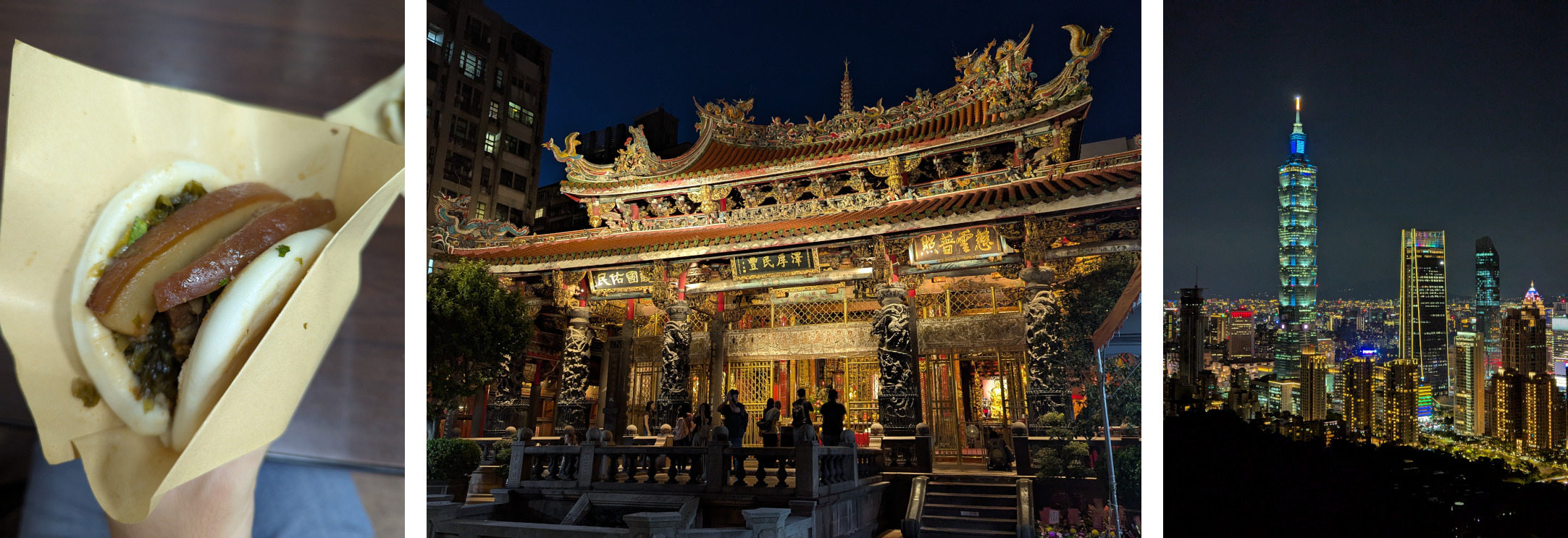
Left to right: delicious guabao, Lungshan Temple, the night skyline
I hadn’t planned anything for my final day other than packing up my things, having lunch, and slowly making my way to the airport, but fate wouldn’t let me waste my final few hours lazing around! After waking up far too early for no reason, I found myself with quite a long morning to fill, so I had the chance to tick off a few more exciting Taipei attractions.
Having already seen the Chiang Kai-shek Memorial Hall beside Liberty Square, I began the morning by visiting the equally impressive Sun Yat-sen Memorial Hall, a huge monument to China’s first president, the only modern-era Chinese leader revered on both sides of the Strait. Set in the beautiful and peaceful Zhongshan Park in the shadow of Taipei 101, it was a really relaxing place to start what would end up being nearly a 48-hour day!
Being so close to the tallest building in Taiwan, and such an iconic one at that, I finally gave in to the urge of seeing the view from the top - in my defence, it had been nearly 6 weeks since I went up the Shanghai Tower - and splashed out to visit the observatory. Despite a month in China, which has 115 buildings taller than the UK’s tallest, the Shard, the novelty of ridiculously tall skyscrapers had not worn off at all. As well as the incredible view (it’s so much taller than anything else in Taipei), there was a really cool exhibition about the tuned mass damper, a 660-tonne ball of steel suspended inside from the 92nd floor, which absorbs vibrations from Taiwan’s more than 200 annual earthquakes to stop the building falling down. Seeing and learning about such a seemingly simple but absolutely critical piece of engineering was fascinating, and whoever decided to open what is usually a hidden implementation detail of a building to the public is a genius.
By the time I was back on the ground, it was almost time to start heading for the airport to get up in the sky again, but I made two vital stops on the way. Firstly, the Presidential Office, a symbol of Taiwan and a pretty great piece of architecture, complete with just two guards outside. And secondly, much more importantly, a really sketchy little restaurant (and by now I had learnt that the sketchier, the better) for an even greater symbol of Taiwan, a delicious beef noodle soup, which would be my final meal in the East before heading back home. Or would it?
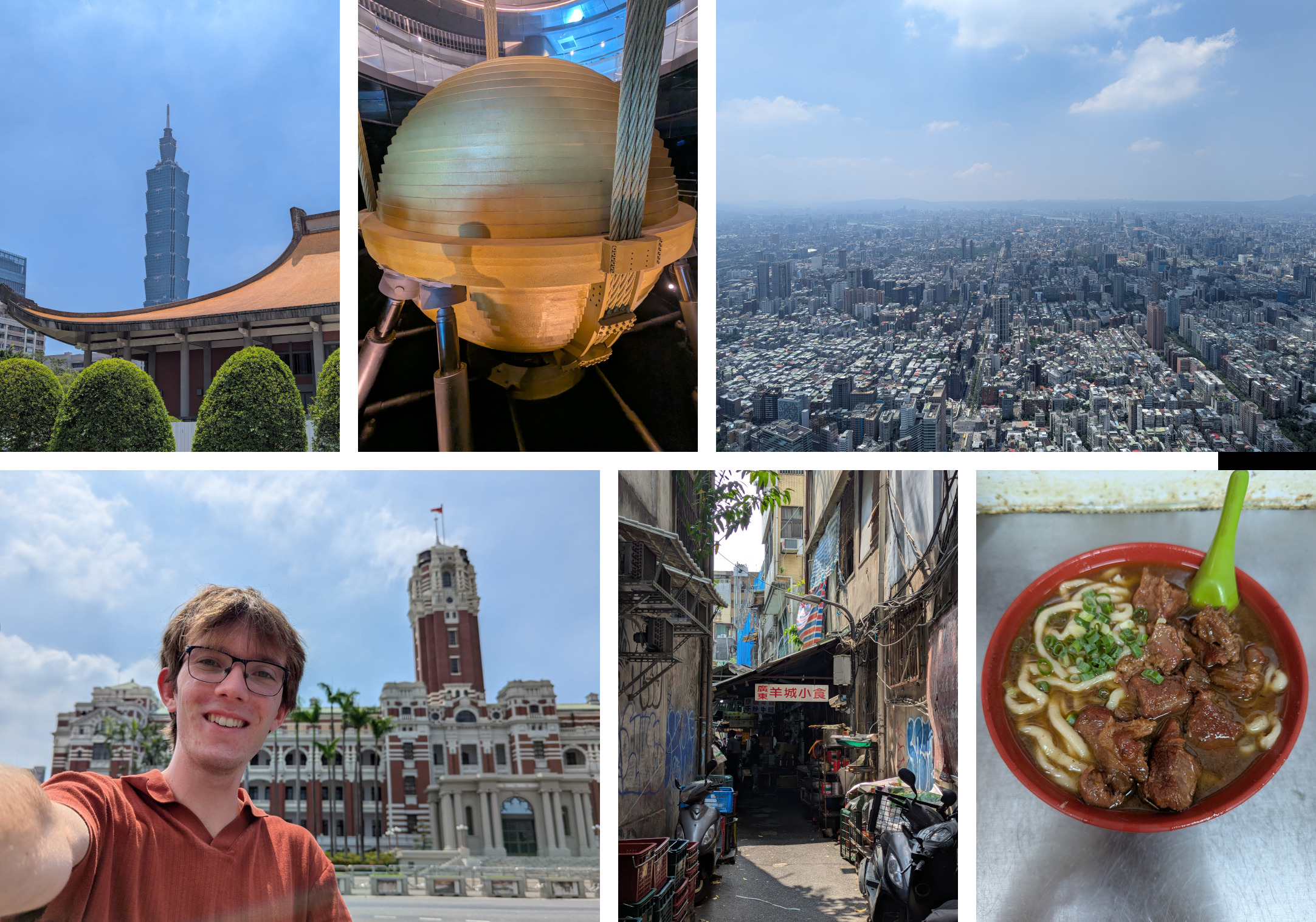
Clockwise: Sun Yat-sen Memorial Hall, the tuned mass damper, the view, beef noodle soup, a street leading to the restaurant, me and the Presidential Office
After my late lunch, I began the long journey home with a flight to Beijing, where I was scheduled to have a four-hour layover. Unfortunately for me, my flight arrived nearly an hour early (not sure how that can happen on such a short flight, but sure), and even more unfortunately, my connecting flight was already showing a delay of nearly two hours. But then I realised - that’s fate yet again giving me more time to spend in China!
I raced to immigration to try and make the most of my very limited bonus time in Beijing, where the very confused lady couldn’t understand why I thought there was time to leave the airport, but let me do so anyway, and I took the train into the city. The train took me pretty near to Houhai, and I couldn’t stop smiling as I ran through the streets, the actually really rather cold evening wind in my hair, counting and loving every second of my unexpected late-night adventure. It was 20 degrees colder than Taipei and I was still wearing a t-shirt and shorts, but in my excitement I barely noticed.
Houhai was more peaceful than I remembered - it was now just before the Victory Day parade, and the whole city was shutting down in preparation - so I bought another bowl of baodu (bonus points if you remember what that was without referring back!) and walked alongside the lake, completely content. I bumped into some slightly drunk British students from Imperial on their first day in China and had a chat with them, which was very entertaining, before looking at my phone to discover that my flight had undelayed itself and I really needed to get back to the airport! I took a taxi all the way there for less than half of an Elizabeth line fare to Heathrow, and of course as soon as I arrived the flight decided it was actually joking about being on time, and promptly went back to being delayed. Despite this, it was lucky I got back when I did, because it took me nearly an hour and a half to get through security and immigration - the single security officer on duty made me take all the coins out of my wallet!
Eventually I made it onto the plane, and after precisely zero sleep, I found myself sleepwalking onto the Gatwick Express to go and have brunch with my friends in London, the most amazing trip of my life behind me, and an even more amazing future to come.

总结 Conclusion
So, to indulge myself in the far-overdone cliché of ending as one begins…
What is China really like?
Six weeks, millions of steps, thousands of miles, and more than 16,000 words later, I’m finally back in London, sitting in my almost-homely new flat, trying to put together some intelligent-sounding words to answer the question that inspired my whole adventure in the first place. Is it the perfect, beautiful, high-tech utopia I saw on Instagram reels? Or is it every bit as bad as the equally trustworthy Western headlines declare?
The answer is, predictably, neither. It’s far better than either side’s caricature - it’s a real place, with real people, living real lives.
Real places don’t fit nicely into the binary categories our logical brains love to impose on them. Dystopia or paradise? Modern or backward? China is all of these things at once. From the ancient bustling streets of Xi’an to the carefree modernity of Chengdu, the unnerving security of Tiananmen Square to the intense freedom of zooming around the villages of Guangxi on a questionably-legal moped, every new city I explored, mountain I climbed, and person I spoke to revealed new sides of China I’d never even thought of. The past six weeks were the greatest adventure of my life, but six weeks was far too little to even scratch the surface, and with every £15 bowl of noodles I eat in London I’ll be counting down the days until I can return for part two.
At least I brought a little piece of China home to keep me company in the meantime.
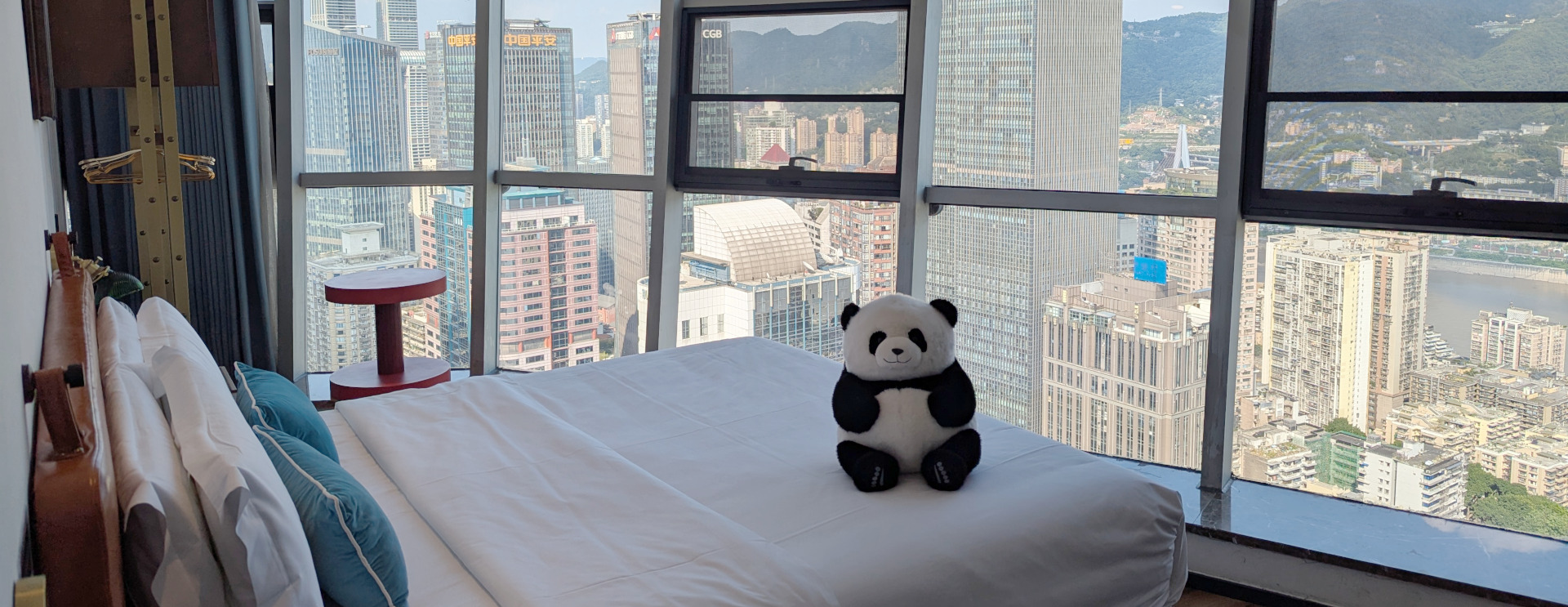
Thank you so much for getting to the end of this ridiculously long blog post! I feel like I’ve written “this is not a travel blog” in so many of my previous posts, and that still stands - to some extent - but I hope you enjoyed something a bit different to my usual writing. Please let me know what you thought, and I’ll see you next time. 再见!